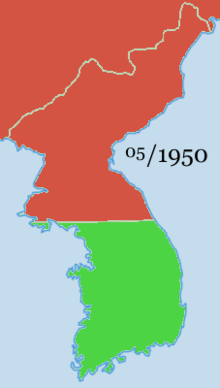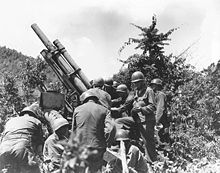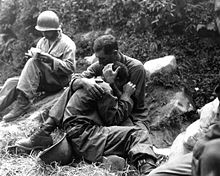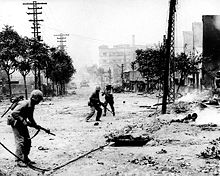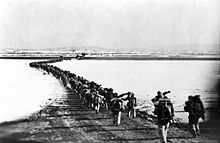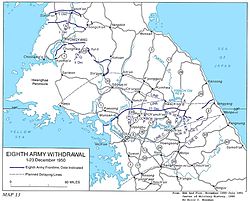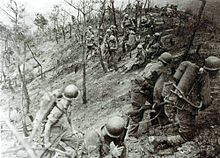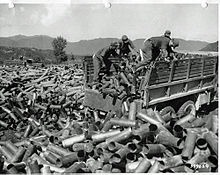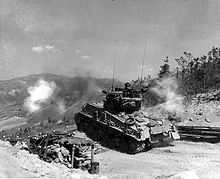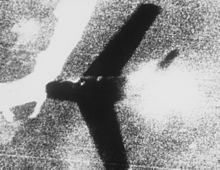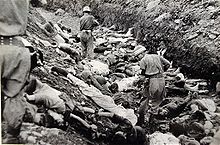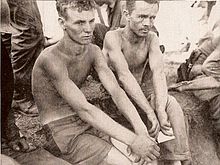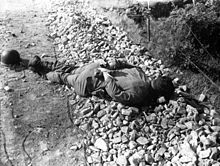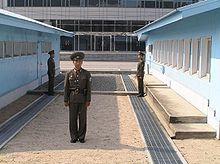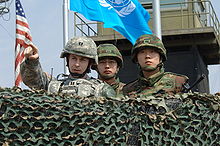- Korean War
-
Korean War Part of the Cold War 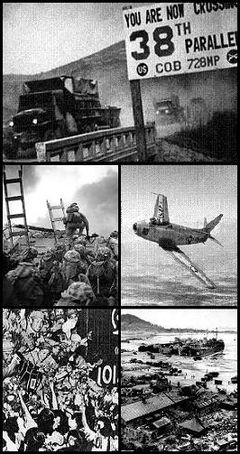
Clockwise, from top: UN forces reach the 38th parallel; F-86 Sabre fighter aircraft in Korean combat; Incheon harbour, starting point of the Battle of Inchon; Chinese soldiers welcomed home; 1st. Lt. Baldomero Lopez, USMC, over the top of the Incheon seawall.Date 25 June 1950 – present
(Armistice signed 27 July 1953)
(61 years, 148 days)Location Korean Peninsula Status - Cease-fire armistice
- North Korean invasion of South Korea repelled
- UN invasion of North Korea repelled
- Chinese invasion of South Korea repelled
- UN invasion of China repelled
- Korean Demilitarized Zone established, little territorial change at the 38th parallel border, essentially uti possidetis
Territorial
changesDMZ; both gained little border territory at the 38th parallel. Belligerents Combat supportSupplies support Argentina
Argentina Allied-occupied Austria
Allied-occupied Austria Bolivia
Bolivia Brazil
Brazil Union of Burma
Union of Burma Protectorate of Cambodia
Protectorate of Cambodia Chile
Chile Republic of China
Republic of China Costa Rica
Costa Rica Cuba
Cuba Dominican Republic
Dominican Republic Ecuador
Ecuador El Salvador
El Salvador Kingdom of Egypt
Kingdom of Egypt Federal Republic of Germany
Federal Republic of Germany Guatemala
Guatemala Haiti
Haiti Honduras
Honduras People's Republic of Hungary
People's Republic of Hungary Iceland
Iceland Indonesia
Indonesia Imperial State of Iran
Imperial State of Iran Israel
Israel Jamaica
Jamaica Occupied Japan
Occupied Japan Lebanon
Lebanon Liberia
Liberia Mexico
Mexico Monaco
Monaco Nicaragua
Nicaragua Dominion of Pakistan
Dominion of Pakistan Panama
Panama Paraguay
Paraguay Peru
Peru Saudi Arabia
Saudi Arabia Switzerland
Switzerland Republic of Syria
Republic of Syria Uruguay
Uruguay Venezuela
Venezuela State of Vietnam
State of Vietnam
Postwar support Democratic People's Republic of Korea
Democratic People's Republic of Korea People's Republic of China
People's Republic of China Union of Soviet Socialist Republics
Union of Soviet Socialist Republics
Commanders and leaders  Rhee Syngman
Rhee Syngman
 Shin Sung-mo
Shin Sung-mo
 Lee Ki-boong
Lee Ki-boong
 Shin Tae-young
Shin Tae-young
 Son Won-il
Son Won-il
 Douglas MacArthur
Douglas MacArthur
 Matthew Ridgway
Matthew Ridgway
 Mark Wayne Clark
Mark Wayne Clark
Current
 Lee Myung-bak
Lee Myung-bak
 Kim Kwan-jin
Kim Kwan-jin
 Jeong Seung-jo
Jeong Seung-jo
 Kim Sang-ki
Kim Sang-ki
 Choi Yoon-hee
Choi Yoon-hee
 Park Jong-heon
Park Jong-heon
 James D. Thurman
James D. Thurman Kim Il-sung
Kim Il-sung
 Pak Hon-yong
Pak Hon-yong
 Choi Yong-kun
Choi Yong-kun
 Kim Chaek
Kim Chaek
 Mao Zedong
Mao Zedong
 Peng Dehuai
Peng Dehuai
 Joseph Stalin
Joseph Stalin
Current
 Kim Jong-il
Kim Jong-il
 Kim Jong-un
Kim Jong-un
 Kim Yong-Chun
Kim Yong-Chun
 Ri Yong-ho
Ri Yong-hoStrength  600,000
600,000
 302,000[3]
302,000[3]
 14,200[3]
14,200[3]
 6,150[3]
6,150[3]
 5,460[3]
5,460[3]
 2,280[3]
2,280[3]
 1,500[3]
1,500[3]
 1,390[3]
1,390[3]
 1,290[3]
1,290[3]
 1,270[3]
1,270[3]
 1,260[3]
1,260[3]
 1,120[3]
1,120[3]
 1,070[3]
1,070[3]
 900[3]
900[3]
 820[3]
820[3]
 300[3]
300[3]
 170[3]
170[3]
 105[3]
105[3]
 100[3]
100[3]
 72[3]
72[3]
 70[3]
70[3]
 44[3]
44[3]
Total: 941,600
 260,000
260,000
 926,000
926,000
 26,000
26,000
Total: 1,212,000
Note: The figures vary by source; peak unit-strength varied during war.
Casualties and losses  Republic of Korea[3]
Republic of Korea[3]
137,899 dead
450,742 wounded
24,495 MIA
8,343 POW
 United States[3]
United States[3]
36,940 dead
92,134 wounded
3,737 MIA
4,439 POW
 United Kingdom[3]
United Kingdom[3]
1,078 dead
2,674 wounded
179 MIA
977 POW
 Turkey[3]
Turkey[3]
741 dead
2,068 wounded
163 MIA
244 POW
 Australia[3]
Australia[3]
339 dead
1,216 wounded
3 MIA
26 POW
 Canada[3]
Canada[3]
312 dead
1,212 wounded
1 MIA
32 POW
 France[3]
France[3]
262 dead
1,008 wounded
7 MIA
12 POW
 Kingdom of Greece[3]
Kingdom of Greece[3]
192 dead
543 wounded
3 POW
 Colombia[3]
Colombia[3]
163 dead
448 wounded
28 POW
 Thailand[3]
Thailand[3]
129 dead
1,139 wounded
5 MIA
 Ethiopian Empire[3]
Ethiopian Empire[3]
121 dead
536 wounded
 Netherlands[3]
Netherlands[3]
120 dead
645 wounded
 Philippines[3]
Philippines[3]
112 dead
229 wounded
16 MIA
41 POW
 Belgium[3]
Belgium[3]
99 dead
336 Wounded
4 MIA
1 POW
 Union of South Africa[3]
Union of South Africa[3]
34 dead
9 POW
 New Zealand[3]
New Zealand[3]
23 dead
79 wounded
1 MIA
 Norway[3]
Norway[3]
3 dead
 Luxembourg[3]
Luxembourg[3]
2 dead
13 wounded
Total: 776,360- 178,569 dead
- 555,022 wounded
- 28,611 MIA
- 14,158 POW
D.P.R. Korea:
215,000 dead
303,000 wounded
120,000 MIA or POW[4]
P.R. China
(Official data):
183,108 dead (including non-combat deaths)
383,218 wounded
25,621 MIA
21,400 POW[5][6][7]
(U.S. estimate):[4]
400,000+ dead
486,000 wounded
21,000 POW
Soviet Union:
282 dead[8]
Total: 1,187,682–1,545,822Total civilians killed/wounded: 2.5 million (est.)[3]
South Korea: 990,968
373,599 killed[3]
229,625 wounded[3]
387,744 abducted/missing[3]
North Korea: 1,550,000 (est.)[3]Korean War- Ongjin
- Kaesong-Munsan
- Gorangpo
- Dongducheon
- Pocheon
- Chuncheon
- Gangneung
- Gimpo
- Okgye
- Korea Strait
- Uijeongbu
- Naechon-Taereung
- Changdong
- Bongilcheon
- Miari
- Hongcheon
- Han River
- Oryudong
- Sinsadong-Gwacheon
- Uljin-Pyeonghae
- Siheung-Anyang-Suwon)
- Jumunjin
- Air campaign
- Suwon Airfield
- Osan
- Pyongtaek
- Chonan
- Chochiwon
- Donglakri
- Danyang
- Jincheon
- Yihwaryeong
- Taejon
- Sangju
- Yeongdeok
- Yongdong
- Hwanggan
- Hwaryeongjang
- Younggang
- Andong
- Hadong
- The Notch
August Offensive
- Pusan Perimeter
- Haeju
- Inchon
- 2nd Seoul
- Hill 282
- Kaesong
- Operation Wonsan
- Wonsan
- Hungham
- Yongju
- Yeonghung
- Kumchon
- Pyongyang
- Huichon
- Chongju
- Chosan
Chinese intervention
- Onjong
- Unsan
- Pakchon
- Ch'ongch'on River
- Wawon
- Chosin Reservoir
- Task Force Faith
- 3rd Seoul
- 1st and 2nd Wonju
- Thunderbolt
- Twin Tunnels
- Roundup
- Hoengsong
- Chipyong-ni
- 3rd Wonju
- Killer
- 4th Seoul
- Courageous
- Tomahawk
- Rugged and Dauntless
- 5th Seoul (Imjin River
- Yultong
- Kapyong)
- Soyang River
Stalemate
- Bloody Ridge
- Han River
- Heartbreak Ridge
- Maryang San
- Sunchon
- Hill Eerie
- Sui-ho Dam
- Old Baldy
- Blaze
- Hudson Harbor
- White Horse
- Triangle Hill
- Jackson Heights
- The Hook
- Pork Chop Hill
- Outpost Harry
- Kumsong
- Samichon River
Post Armistice
- Korean DMZ Conflict (1966–1969)
- Blue House Raid
- Pueblo incident
- EC-121 shootdown
- Major Henderson incident
- Axe murder incident
- Rangoon bombing
- KAL Flight 858
- Gangneung
- Yosu
- 1st Yeonpyeong
- 2nd Yeonpyeong
- Daecheong
- Cheonan incident
- 3rd Yeonpyeong
The Korean War (25 June 1950 – armistice signed 27 July 1953[9]) was a conventional war between South Korea, supported by the United Nations, and North Korea, supported by the People's Republic of China (PRC), with military material aid from the Soviet Union. The war was a result of the physical division of Korea by an agreement of the victorious Allies at the conclusion of the Pacific War at the end of World War II. The Korean peninsula was ruled by Japan from 1910 until the end of World War II. Following the surrender of Japan in 1945, American administrators divided the peninsula along the 38th Parallel, with United States troops occupying the southern part and Soviet troops occupying the northern part.[10]
The failure to hold free elections throughout the Korean Peninsula in 1948 deepened the division between the two sides, and the North established a Communist government. The 38th Parallel increasingly became a political border between the two Koreas. Although reunification negotiations continued in the months preceding the war, tension intensified. Cross-border skirmishes and raids at the 38th Parallel persisted. The situation escalated into open warfare when North Korean forces invaded South Korea on 25 June 1950.[11] It was the first significant armed conflict of the Cold War.[12]
The United Nations, particularly the United States, came to the aid of South Korea in repelling the invasion, but within two months the defenders were pushed back to the Pusan perimeter, a small area in the south of the country, before the North Koreans were stopped. A rapid UN counter-offensive then drove the North Koreans past the 38th Parallel and almost to the Yalu River, and the People's Republic of China (PRC) entered the war on the side of the North.[11] The Chinese launched a counter-offensive that pushed the United Nations forces back across the 38th Parallel. The Soviet Union materially aided the North Korean and Chinese armies. In 1953, the war ceased with an armistice that restored the border between the Koreas near the 38th Parallel and created the Korean Demilitarized Zone (DMZ), a 2.5-mile (4.0 km) wide buffer zone between the two Koreas. Minor outbreaks of fighting continue to the present day.
With both North and South Korea sponsored by external powers, the Korean War was a proxy war. From a military science perspective, it combined strategies and tactics of World War I and World War II: it began with a mobile campaign of swift infantry attacks followed by air bombing raids, but became a static trench war by July 1951.
Background
Etymology
In the United States, the war was initially described by President Harry S. Truman as a "police action" as it was conducted under the auspices of the United Nations.[13] Colloquially, it has been referred to in the United States as The Forgotten War or The Unknown War. The issues concerned were much less clear than in previous and subsequent conflicts, such as World War II and the Vietnam War.[14][15] To a significant degree, the war has been "historically overshadowed by World War II and Vietnam".[16]
In South Korea the war is usually referred to as "625" or the 6–2–5 Upheaval (yug-i-o dongnan), reflecting the date of its commencement on 25 June.[17] In North Korea the war is officially referred to as the Fatherland Liberation War (Choguk haebang chǒnjaeng). Alternatively, it is called the Chosǒn chǒnjaeng ("Chosǒn war", Chosǒn being what North Koreans call Korea).[18] In the People's Republic of China the war is called the War to Resist U.S. Aggression and Aid Korea (traditional Chinese: 抗美援朝戰爭; simplified Chinese: 抗美援朝战争; pinyin: Kàngměiyuáncháo zhànzhēng).[19][20] The "Korean War" (朝鮮戰爭/朝鲜战争; pinyin: Cháoxiǎn zhànzhēng) is more commonly used today. Cháoxiǎn is the Chinese pronunciation of the Korean name "Chosǒn".
Japanese rule (1910–1945)
Main article: Korea under Japanese ruleUpon defeating the Qing Dynasty in the First Sino-Japanese War (1894–96), the Empire of Japan occupied the Korean Empire – a peninsula strategic to its sphere of influence.[21] A decade later, defeating Imperial Russia in the Russo-Japanese War (1904–05), Japan made Korea its protectorate with the Eulsa Treaty in 1905, then annexed it with the Japan–Korea Annexation Treaty in 1910.[22][23]
Korean nationalists and the intelligentsia fled the country, and some founded the Provisional Korean Government in 1919, which was headed by Syngman Rhee in Shanghai. This government-in-exile was recognized by few countries. From 1919 to 1925 and beyond, Korean communists led and were the primary agents of internal and external warfare against the Japanese.[21]:23[24]
Korea under Japanese rule was considered to be part of the Empire of Japan as an industrialized colony along with Taiwan, and both were part of the Greater East Asia Co-Prosperity Sphere. In 1937, the colonial Governor-General, General Jirō Minami, commanded the attempted cultural assimilation of Korea's 23.5 million people by banning the use and study of Korean language, literature, and culture, to be replaced with that of mandatory use and study of their Japanese counterparts. Starting in 1939, the populace was required to use Japanese names under the Sōshi-kaimei policy. In 1938, the Colonial Government established labor conscription.[citation needed]
In China, the National Revolutionary Army and the Communist People's Liberation Army helped organize refugee Korean patriots and independence fighters against the Japanese military, which had also occupied parts of China. The Nationalist-backed Koreans, led by Yi Pom-Sok, fought in the Burma Campaign (December 1941 – August 1945). The Communists, led by Kim Il-sung, fought the Japanese in Korea and Manchuria.[citation needed]
During World War II, the Japanese used Korea's food, livestock, and metals for their war effort. Japanese forces in Korea increased from 46,000 soldiers in 1941 to 300,000 in 1945. Japanese Korea conscripted 2.6 million forced laborers controlled with a collaborationist Korean police force; some 723,000 people were sent to work in the overseas empire and in metropolitan Japan. By 1942, Korean men were being conscripted into the Imperial Japanese Army. By January 1945, Koreans comprised 32% of Japan's labor force. In August 1945, when the United States dropped atomic bombs on Hiroshima and Nagasaki, around 25% of those killed were Koreans.[24] At the end of the war, other world powers did not recognize Japanese rule in Korea and Taiwan.
Meanwhile, at the Cairo Conference (November 1943), Nationalist China, the United Kingdom, and the United States decided "in due course Korea shall become free and independent".[25] Later, the Yalta Conference (February 1945) granted to the Soviet Union European "buffer zones"—satellite states accountable to Moscow—as well as an expected Soviet pre-eminence in China and Manchuria,[26] in return for joining the Allied Pacific War effort against Japan.[26]
Soviet invasion of Manchuria (1945)
Main article: Soviet invasion of Manchuria (1945)Toward the end of World War II, as per a US-Soviet agreement, the USSR declared war against Japan on 9 August 1945.[24][27] By 10 August, the Red Army occupied the northern part of the Korean peninsula as agreed, and on 26 August halted at the 38th parallel for three weeks to await the arrival of US forces in the south.[21]:25[21]:24
On 10 August 1945, with the 15 August Japanese surrender near, the Americans doubted whether the Soviets would honor their part of the Joint Commission, the US-sponsored Korean occupation agreement. A month earlier, Colonel Dean Rusk and Colonel Charles H. Bonesteel III divided the Korean peninsula at the 38th parallel after hurriedly deciding (in thirty minutes) that the US Korean Zone of Occupation had to have a minimum of two ports.[28][29][30][31][32]
Explaining why the occupation zone demarcation was positioned at the 38th parallel, Rusk observed, "even though it was further north than could be realistically reached by US forces, in the event of Soviet disagreement ... we felt it important to include the capital of Korea in the area of responsibility of American troops", especially when "faced with the scarcity of US forces immediately available, and time and space factors, which would make it difficult to reach very far north, before Soviet troops could enter the area."[26] The Soviets agreed to the US occupation zone demarcation to improve their negotiating position regarding the occupation zones in Eastern Europe, and because each would accept Japanese surrender where they stood.[21]:25
Chinese Civil War (1945–1949)
Main article: Chinese Civil WarAfter the end of Second Sino-Japanese War, the Chinese Civil War resumed between the Chinese Communists and the Chinese Nationalists. While the Communists were struggling for supremacy in Manchuria, they were supported by the North Korean government with materiel and manpower.[33] According to Chinese sources, the North Koreans donated 2,000 railway cars worth of material while thousands of Korean "volunteers" served in the Chinese People's Liberation Army (PLA) during the war.[34] North Korea also provided the Chinese Communists in Manchuria with a safe refuge for non-combatants and communications with the rest of China.[33]
The North Korean contributions to the Chinese Communist victory were not forgotten after the creation of the People's Republic of China in 1949. As a token of gratitude, between 50,000 to 70,000 Korean veterans that served in the PLA were sent back along with their weapons, and they would later play a significant role in the initial invasion of South Korea.[33] China promised to support the North Koreans in the event of a war against South Korea.[35] The Chinese support created a deep division between the Korean Communists, and Kim Il-Sung's authority within the Communist party was challenged by the Chinese faction led by Pak Il-yu, who was later purged by Kim.[36]
After the formation of the People's Republic of China in 1949, the Chinese government named the Western nations, led by the United States, as the biggest threat to its national security.[37] Basing this judgment on China's century of humiliation beginning in the early 19th century,[38] American support for the Nationalists during the Chinese Civil War,[39] and the ideological struggles between revolutionaries and reactionaries,[40] the Chinese leadership believed that China would become a critical battleground in the United States' crusade against Communism.[41] As a countermeasure and to elevate China's standing among the worldwide Communist movements, the Chinese leadership adopted a foreign policy that actively promoted Communist revolutions throughout territories on China's periphery.[42]
Korea divided (1945–1949)
See also: Division of KoreaAt the Potsdam Conference (July–August 1945), the Allies unilaterally decided to divide Korea—without consulting the Koreans—in contradiction of the Cairo Conference.[21]:24[29]:24–5[43]:25[44]
On 8 September 1945, Lt. Gen. John R. Hodge of the United States arrived in Incheon to accept the Japanese surrender south of the 38th parallel.[29] Appointed as military governor, General Hodge directly controlled South Korea via the United States Army Military Government in Korea (USAMGIK 1945–48).[45]:63 He established control by restoring to power the key Japanese colonial administrators and their Korean police collaborators.[12] The USAMGIK refused to recognise the provisional government of the short-lived People's Republic of Korea (PRK) because he suspected it was communist. These policies, voiding popular Korean sovereignty, provoked civil insurrections and guerrilla warfare.[22] On 3 September 1945, Lieutenant General Yoshio Kozuki, Commander, Japanese Seventeenth Area Army, contacted Hodge, telling him that the Soviets were south of the 38th parallel at Kaesong. Hodge trusted the accuracy of the Japanese Army report.[29]
In December 1945, Korea was administered by a US–USSR Joint Commission, as agreed at the Moscow Conference (1945). The Koreans were excluded from the talks. The commission decided the country would become independent after a five-year trusteeship action facilitated by each régime sharing its sponsor's ideology.[21]:25–6[46] The Korean populace revolted; in the south, some protested, and some rose in arms;[22] to contain them, the USAMGIK banned strikes on 8 December 1945 and outlawed the PRK Revolutionary Government and the PRK People's Committees on 12 December 1945.
On 23 September 1946 an 8,000-strong railroad worker strike began in Pusan. Civil disorder spread throughout the country in what became known as the Autumn uprising. On 1 October 1946, Korean police killed three students in the Daegu Uprising; protesters counter-attacked, killing 38 policemen. On 3 October, some 10,000 people attacked the Yeongcheon police station, killing three policemen and injuring some 40 more; elsewhere, some 20 landlords and pro-Japanese South Korean officials were killed.[47] The USAMGIK declared martial law.
The right-wing Representative Democratic Council, led by nationalist Syngman Rhee, opposed the Soviet–American trusteeship of Korea, arguing that after 35 years (1910–45) of Japanese colonial rule most Koreans opposed another foreign occupation. The USAMGIK decided to forego the five year trusteeship agreed upon in Moscow, given the 31 March 1948 United Nations election deadline to achieve an anti-communist civil government in the US Korean Zone of Occupation.
On 3 April what began as a demonstration commemorating Korean resistance to Japanese rule ended with the Jeju massacre of as many as 60,000 citizens by South Korean soldiers.[48]
On 10 May, South Korea convoked their first national general elections that the Soviets first opposed, then boycotted, insisting that the US honor the trusteeship agreed to at the Moscow Conference.[21]:26[49][50][51]
North Korea held parliamentary elections three months later on 25 August 1948.[52]
The resultant anti-communist South Korean government promulgated a national political constitution on 17 July 1948, elected a president, the American-educated strongman Syngman Rhee on 20 July 1948. The elections were marred by terrorism and sabotage resulting in 600 deaths.[53] The Republic of Korea (South Korea) was established on 15 August 1948.[54] In the Russian Korean Zone of Occupation, the USSR established a Communist North Korean government[21]:26 led by Kim Il-sung.[55] President Rhee's régime expelled communists and leftists from southern national politics. Disenfranchised, they headed for the hills, to prepare for guerrilla war against the US-sponsored ROK Government.[55]
As nationalists, both Syngman Rhee and Kim Il-Sung were intent upon reunifying Korea under their own political system.[21]:27 With Joseph Stalin and Mao Zedong fighting over the control of the Korean Peninsula,[56] the North Koreans gained support from both the Soviet Union and the People's Republic of China. They escalated the continual border skirmishes and raids and then prepared to invade. South Korea, with limited matériel, could not match them.[21]:27 During this era, at the beginning of the Cold War, the US government assumed that all communists, regardless of nationality, were controlled or directly influenced by Moscow; thus the US portrayed the civil war in Korea as a Soviet hegemonic maneuver.[57]
In October 1948, South Korean left-wing soldiers rebelled against the government's harsh clampdown in April on Jeju island in the Yeosu-Suncheon Rebellion.[58]
The Soviet Union withdrew as agreed from Korea in 1948. U.S. troops withdrew from Korea in 1949, leaving the South Korean army relatively ill-equipped. On 24 December 1949, South Korean forces killed 86 to 88 people in the Mungyeong massacre and blamed the crime on communist marauding bands.[59]
Course of the war
The conflict begins (June 1950)
In April 1950 Kim Il-sung travelled to Moscow and secured Stalin's support for a policy to unify Korea under his authority. Although agreeing with the invasion of South Korea in principle, Stalin refused to become directly involved in Kim's plans, and advised Kim to enlist Chinese support instead. In May 1950 Kim visited Beijing, and succeeded in gaining Mao's endorsement. At the time, Mao's support for Kim was largely political (he was contemplating the invasions of Taiwan and Tibet), and was unaware of Kim's precise intentions or the timing of Kim's attack. When the Korean war broke out, the Chinese were in the process of demobilizing half of the PLA's 5.6 million soldiers.[60]
After the US missions had left the People's Republic of China, CIA China station officer Douglas Mackiernan volunteered to remain and conduct spy operations. Afterward, he and a team of indigenous personnel then escaped China in a months-long horse trek across the Himalaya mountains; he was killed within miles of Lhasa. His team delivered the intelligence to headquarters that invasion was imminent. Thirteen days later on 25 June 1950, the North Korean People's Army (KPA) crossed the 38th parallel border and invaded South Korea. Mackiernan was posthumously awarded the CIA Intelligence Star for valor.[61]
Under the guise of counter-attacking a South Korean provocation raid, the KPA crossed the 38th parallel behind artillery fire at dawn on Sunday 25 June 1950.[21]:14 The KPA said that Republic of Korea Army (ROK Army) troops, under command of the régime of the "bandit traitor Syngman Rhee", had crossed the border first, and that they would arrest and execute Rhee.[29] Both Korean armies had continually harassed each other with skirmishes and each continually staged raids across the 38th parallel border.
On 27 June, Rhee evacuated from Seoul with government officials. Rhee ordered the Bodo League massacre, which started on 28 June.[62]
On 28 June, South Korea bombed the bridge across the Han River to stop the North Korean army.[63]
Early on in the fighting, South Korea put its forces under the authority of the United Nations Command (Korea).[64]
Factors in US intervention
The Truman Administration was caught at a crossroads. Before the invasion, Korea was not included in the strategic Asian Defense Perimeter outlined by Secretary of State Acheson.[65] Military strategists were more concerned with the security of Europe against the Soviet Union than East Asia. At the same time, the Administration was worried that a war in Korea could quickly widen into another world war should the Chinese or Soviets decide to get involved as well.
One facet of the changing attitude toward Korea and whether to get involved was Japan. Especially after the fall of China to the Communists, "...Japan itself increasingly appeared as the major East Asian prize to be protected". US East Asian experts saw Japan as the critical counterweight to the Soviet Union and China in the region. While there was no United States policy that dealt with South Korea directly as a national interest, its proximity to Japan pushed South Korea to the fore. "The recognition that the security of Japan required a non-hostile Korea led directly to President Truman’s decision to intervene... The essential point... is that the American response to the North Korean attack stemmed from considerations of US policy toward Japan."[65] The United States wanted to shore up Japan to make it a viable counterweight against the Soviet Union and China, and Korea was seen as integral to that end.
The other important part of committing to intervention lay in speculation about Soviet action in the event that the United States intervene. The Truman administration was fretful that a war in Korea was a diversionary assault that would escalate to a general war in Europe once the US committed in Korea. At the same time, "[t]here was no suggestion from anyone that the United Nations or the United States could back away from [the conflict]".[66] In Truman’s mind, this aggression, if left unchecked, would start a chain reaction that would destroy the United Nations and give the go ahead to further Communist aggression elsewhere. Korea was where a stand had to be made, the difficult part was how. The UN Security council approved the use of force to help the South Koreans and the US immediately began using air and naval forces in the area to that end. The Administration still refrained from committing on the ground because some advisors believed the North Koreans could be stopped by air and naval power alone.[66] Also, it was still uncertain if this was a clever ploy by the Soviet Union to catch the US unawares or just a test of US resolve. The decision to commit ground troops and to intervene eventually became viable when a communiqué was received on 27 June from the Soviet Union that alluded it would not move against US forces in Korea. "This opened the way for the sending of American ground forces, for it now seemed less likely that a general war—with Korea as a preliminary diversion—was imminent".[66] With the Soviet Union’s tacit agreement that this would not cause an escalation, the United States now could intervene with confidence that other commitments would not be jeopardized.
United Nations Security Council Resolutions
On 25 June 1950, the United Nations Security Council unanimously condemned the North Korean invasion of the Republic of Korea, with United Nations Security Council Resolution 82. The USSR, a veto-wielding power, had boycotted the Council meetings since January 1950, protesting that the Republic of China (Taiwan), not the People's Republic of China, held a permanent seat in the UN Security Council.[67] After debating the matter, the Security Council, on 27 June 1950, published Resolution 83 recommending member states provide military assistance to the Republic of Korea. On 27 June President Truman ordered US air and sea forces to help the South Korean régime. On 4 July the Soviet Deputy Foreign Minister accused the US of starting armed intervention on behalf of South Korea.[68]
The USSR challenged the legitimacy of the war for several reasons. The ROK Army intelligence upon which Resolution 83 was based came from US Intelligence; North Korea was not invited as a sitting temporary member of the UN, which violated UN Charter Article 32; and the Korean conflict was beyond UN Charter scope, because the initial north–south border fighting was classed as a civil war. The Soviet representative boycotted the UN to prevent Security Council action, and to challenge the legitimacy of the UN action; legal scholars posited that deciding upon an action of this type required the unanimous vote of the five permanent members.[69][70]
Comparison of military forces
The North Korean Army launched the "Fatherland Liberation War" with a comprehensive air–land invasion using 231,000 soldiers, who captured scheduled objectives and territory, among them Kaesong, Chuncheon, Uijeongbu, and Ongjin. Their forces included 274 T-34-85 tanks, some 150 Yak fighters, 110 attack bombers, 200 artillery pieces, 78 Yak trainers, and 35 reconnaissance aircraft.[29] In addition to the invasion force, the North Korean KPA had 114 fighters, 78 bombers, 105 T-34-85 tanks, and some 30,000 soldiers stationed in reserve in North Korea.[29] Although each navy consisted of only several small warships, the North Korean and South Korean navies fought in the war as sea-borne artillery for their in-country armies.
In contrast, the ROK Army defenders were vastly unprepared, and the political establishment in the south, while well aware of the threat to the north, were unable to convince American administrators of the reality of the threat. In South to the Naktong, North to the Yalu (1961), R.E. Appleman reports the ROK forces' low combat readiness as of 25 June 1950. The ROK Army had 98,000 soldiers (65,000 combat, 33,000 support), no tanks (they had been requested from the US military, but requests were denied), and a 22–piece air force comprising 12 liaison-type and 10 AT6 advanced-trainer airplanes. There were no large foreign military garrisons in Korea at invasion time, but there were large US garrisons and air forces in Japan.[29]
Within days of the invasion, masses of ROK Army soldiers—of dubious loyalty to the Syngman Rhee régime—were either retreating southwards or were defecting en masse to the northern side, the KPA.[21]:23
United Nations response (July – August 1950)
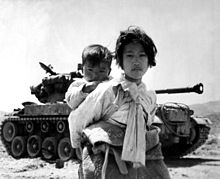 Korean civilians pass an M-46 tank
Korean civilians pass an M-46 tank
Despite the rapid post–Second World War Allied demobilizations, there were substantial US forces occupying Japan; under General Douglas MacArthur's command, they could be made ready to fight the North Koreans.[21]:42 Only the British Commonwealth had comparable forces in the area.
On Saturday, 24 June 1950, US Secretary of State Dean Acheson informed President Truman by telephone, "Mr. President, I have very serious news. The North Koreans have invaded South Korea."[71][72] Truman and Acheson discussed a US invasion response with defense department principals, who agreed that the United States was obligated to repel military aggression, paralleling it with Adolf Hitler's 1930s aggressions, and said that the mistake of appeasement must not be repeated.[73] In his autobiography, President Truman acknowledged that fighting the invasion was essential to the American goal of the global containment of communism as outlined in the National Security Council Report 68 (NSC-68) (declassified in 1975):
-
"Communism was acting in Korea, just as Hitler, Mussolini and the Japanese had ten, fifteen, and twenty years earlier. I felt certain that if South Korea was allowed to fall Communist leaders would be emboldened to override nations closer to our own shores. If the Communists were permitted to force their way into the Republic of Korea without opposition from the free world, no small nation would have the courage to resist threat and aggression by stronger Communist neighbors."[74]
President Truman announced that the US would counter "unprovoked aggression" and "vigorously support the effort of the [UN] security council to terminate this serious breach of peace."[72] In Congress, the Joint Chiefs of Staff Chairman General Omar Bradley warned against appeasement, saying that Korea was the place "for drawing the line" against communist expansion. In August 1950, the President and the Secretary of State obtained the consent of Congress to appropriate $12 billion to pay for the military expenses.[72]
Per State Secretary Acheson's recommendation, President Truman ordered General MacArthur to transfer materiel to the Army of the Republic of Korea while giving air cover to the evacuation of US nationals. The President disagreed with advisors who recommended unilateral US bombing of the North Korean forces, and ordered the US Seventh Fleet to protect the Republic of China (Taiwan), whose Nationalist Government asked to fight in Korea. The US denied the Nationalist Chinese request for combat, lest it provoke a communist Chinese retaliation.[75] Because the US had sent the Seventh Fleet to "neutralize" the Taiwan Strait, Chinese premier Zhou Enlai criticized both the UN and US initiatives as "armed aggression on Chinese territory."[76]
The Battle of Osan, the first significant American engagement of the Korean War, involved the 540-soldier Task Force Smith, which was a small forward element of the 24th Infantry Division.[21]:45 On 5 July 1950, Task Force Smith attacked the North Koreans at Osan but without weapons capable of destroying the North Koreans' tanks. They were unsuccessful; the result was 180 dead, wounded, or taken prisoner. The KPA progressed southwards, pushing back the US force at Pyongtaek, Chonan, and Chochiwon, forcing the 24th Division's retreat to Taejeon, which the KPA captured in the Battle of Taejon;[21]:48 the 24th Division suffered 3,602 dead and wounded and 2,962 captured, including the Division's Commander, Major General William F. Dean.[21]:48 Overhead, the KPAF shot down 18 USAF fighters and 29 bombers; the USAF shot down five KPAF fighters.[citation needed]
By August, the KPA had pushed back the ROK Army and the Eighth United States Army to the vicinity of Pusan, in southeast Korea.[21]:53 In their southward advance, the KPA purged the Republic of Korea's intelligentsia by killing civil servants and intellectuals.[21]:56 On 20 August, General MacArthur warned North Korean leader Kim Il-Sung that he was responsible for the KPA's atrocities.[21][54]:56 By September, the UN Command controlled only the Pusan perimeter, enclosing only about 10% of Korea, in a line partially defined by the Nakdong River.
Although Kim's early successes had led him to predict that he would end the war by the end of August, Chinese leaders were more pessimistic. To counter the possibility of American invasion, Zhou Enlai secured a Soviet commitment to have the USSR support Chinese forces with air cover, and deployed 260,000 soldiers along the Korean border, under the command of Gao Gang. Zhou commanded Chai Chengwen to conduct a topographical survey of Korea, and directed Lei Yingfu, Zhou's military advisor in Korea, to analyze the military situation in Korea. Lei concluded that Macarthur would most likely attempt a landing at Incheon. After conferring with Mao that this would be MacArthur's most likely strategy, Zhou briefed Soviet and North Korean advisers of Lei's findings, and issued orders to Chinese army commanders deployed on the Korean border to prepare for American naval activity in the Korea Strait.[77]
Escalation (August – September 1950)
 The U.S. Air Force attacking railroads south of Wonsan on the eastern coast of North Korea.
The U.S. Air Force attacking railroads south of Wonsan on the eastern coast of North Korea.
In the resulting Battle of Pusan Perimeter (August–September 1950), the US Army withstood KPA attacks meant to capture the city at the Naktong Bulge, P'ohang-dong, and Taegu. The United States Air Force (USAF) interrupted KPA logistics with 40 daily ground support sorties that destroyed 32 bridges, halting most daytime road and rail traffic. KPA forces were forced to hide in tunnels by day and move only at night.[21]:47–48[21]:66 To deny materiel to the KPA, the USAF destroyed logistics depots, petroleum refineries, and harbors, while the US Navy air forces attacked transport hubs. Consequently, the over-extended KPA could not be supplied throughout the south.[21]:58
Meanwhile, US garrisons in Japan continually dispatched soldiers and materiel to reinforce defenders in the Pusan Perimeter.[21]:59–60 Tank battalions deployed to Korea directly from the United States mainland from the port of San Francisco to the port of Pusan, the largest Korean port. By late August, the Pusan Perimeter had some 500 medium tanks battle ready.[21]:61 In early September 1950, ROK Army and UN Command forces outnumbered the KPA 180,000 to 100,000 soldiers. The UN forces, once prepared, counterattacked and broke out of the Pusan Perimeter.[21][29]:61
Battle of Inchon (September 1950)
Main article: Battle of Inchon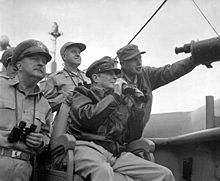 General Douglas MacArthur, UN Command CiC (seated), observes the naval shelling of Incheon from the USS Mt. McKinley, 15 September 1950.
General Douglas MacArthur, UN Command CiC (seated), observes the naval shelling of Incheon from the USS Mt. McKinley, 15 September 1950.
Against the rested and re-armed Pusan Perimeter defenders and their reinforcements, the KPA were undermanned and poorly supplied; unlike the UN Command, they lacked naval and air support.[21]: 58, 61 To relieve the Pusan Perimeter, General MacArthur recommended an amphibious landing at Inchon, well over 100 miles (160 km) behind the KPA lines.[21]:67 On 6 July, he ordered Major General Hobart R. Gay, Commander, 1st Cavalry Division, to plan the division's amphibious landing at Incheon; on 12–14 July, the 1st Cavalry Division embarked from Yokohama, Japan to reinforce the 24th Infantry Division inside the Pusan Perimeter.[78]
Soon after the war began, General MacArthur had begun planning a landing at Incheon, but the Pentagon opposed him.[21]:67 When authorized, he activated a combined United States Army, United States Marine Corps, and ROK Army force. The X Corps, led by General Edward Almond, Commander, consisted of 40,000 men of the 1st Marine Division, the 7th Infantry Division and around 8,600 ROK Army soldiers.[21]:68 By the 15 September attack date, the amphibious assault force faced few KPA defenders at Incheon: military intelligence, psychological warfare, guerrilla reconnaissance, and protracted bombardment facilitated a relatively light battle. However, the bombardment destroyed most of the city of Incheon.[21]:70
After the Incheon landing the 1st Cavalry Division began its northward advance from the Pusan Perimeter. "Task Force Lynch"—3rd Battalion, 7th Cavalry Regiment, and two 70th Tank Battalion units (Charlie Company and the Intelligence–Reconnaissance Platoon)— effected the "Pusan Perimeter Breakout" through 106.4 miles (171.2 km) of enemy territory to join the 7th Infantry Division at Osan.[78] The X Corps rapidly defeated the KPA defenders around Seoul, thus threatening to trap the main KPA force in Southern Korea,[21]:71–2.
On 18 September Stalin dispatched General H.M. Zakharov to Korea to advise Kim Il-sung to halt his offensive around the Pusan perimeter and to redeploy his forces to defend Seoul. Chinese commanders were not briefed on North Korean troop numbers or operational plans. As the overall commander of Chinese forces, Zhou Enlai suggested that the North Koreans should attempt to eliminate the enemy forces at Inchon only if they had reserves of at least 100,000 men; otherwise, he advised the North Koreans to withdraw their forces north.[79]
On 25 September Seoul was recaptured by South Korean forces. American air raids caused heavy damage to the KPA, destroying most of its tanks and much of its artillery. North Korean troops in the south, instead of effectively withdrawing north, rapidly disintegrated, leaving Pyongyang vulnerable.[79] During the general retreat only 25,000 to 30,000 soldiers managed to rejoin the Northern KPA lines.[80][81] On 27 September Stalin convened an emergency session of the Politburo, in which he condemned the incompetence of the KPA command and held Soviet military advisers responsible for the defeat.[79]
UN forces cross partition line (September – October 1950)
Main article: UN Offensive, 1950On 27 September, MacArthur received the top secret National Security Council Memorandum 81/1 from Truman reminding him that operations north of the 38th parallel were authorized only if "at the time of such operation there was no entry into North Korea by major Soviet or Chinese Communist forces, no announcements of intended entry, nor a threat to counter our operations militarily..."[82] On 29 September MacArthur restored the government of the Republic of Korea under Syngman Rhee.[79] On 30 September, Defense Secretary George Marshall sent an eyes-only message to MacArthur: "We want you to feel unhampered tactically and strategically to proceed north of the 38th parallel."[82]
On 30 September Zhou Enlai warned the United States that it was prepared to intervene in Korea if the United States crossed the 38th parallel. Zhou attempted to advise North Korean commanders on how to conduct a general withdrawal by using the same tactics which had allowed Chinese communist forces to successfully escape Chiang Kai-shek's Encirclement Campaigns in the 1930s. North Korean commanders did not utilize these tactics effectively.[83]
By 1 October 1950, the UN Command repelled the KPA northwards, past the 38th parallel; the ROK Army crossed after them, into North Korea.[21]:79–94 MacArthur made a statement demanding the KPA's unconditional surrender.[84] Six days later, on 7 October, with UN authorization, the UN Command forces followed the ROK forces northwards.[21]:81 The X Corps landed at Wonsan (in southeastern North Korea) and Riwon (in northeastern North Korea), already captured by ROK forces.[21]:87–8 The Eighth United States Army and the ROK Army drove up western Korea and captured Pyongyang city, the North Korean capital, on 19 October 1950.[21]:90 The 187th Airborne Regimental Combat Team ("Rakkasans") made their first of the only two combat jumps during the Korean War on 20 October 1950 at Sunchon and Sukchon, North Korea. The missions of the 187th were to cut the road north going to China, preventing North Korean leaders from escaping from Pyongyang; and to rescue American prisoners of war. At month's end, UN forces held 135,000 KPA prisoners of war.
Taking advantage of the UN Command's strategic momentum against the communists, General MacArthur believed it necessary to extend the Korean War into China to destroy depots supplying the North Korean war effort. President Truman disagreed, and ordered caution at the Sino-Korean border.[21]:83
China intervenes (October – December 1950)
On 27 June 1950, two days after the KPA invaded and three months before the Chinese entered the war, President Truman dispatched the United States Seventh Fleet to the Taiwan Strait, to protect the Nationalist Republic of China (Taiwan) from the People's Republic of China (PRC).[85] On 4 August 1950, with the PRC invasion of Taiwan aborted, Mao Zedong reported to the Politburo that he would intervene in Korea when the People's Liberation Army's (PLA) Taiwan invasion force was reorganized into the PLA North East Frontier Force.
On 20 August 1950, Premier Zhou Enlai informed the United Nations that "Korea is China's neighbor... The Chinese people cannot but be concerned about a solution of the Korean question". Thus, via neutral-country diplomats, China warned that in safeguarding Chinese national security, they would intervene against the UN Command in Korea.[21]:83 President Truman interpreted the communication as "a bald attempt to blackmail the UN", and dismissed it.[86]
1 October 1950, the day that UN troops crossed the 38th parallel, was also the first anniversary of the founding of the People's Republic of China. On that day the Soviet ambassador forwarded a telegram from Stalin to Mao and Zhou requesting that China send five to six divisions into Korea, and Kim Il-sung sent frantic appeals to Mao to request Chinese military intervention. At the same time, Stalin made it clear that Soviet forces themselves would not directly intervene.[84]
In a series of emergency meetings that lasted from 2–5 October, Chinese leaders debated whether to send Chinese troops into Korea. There was considerable resistance among many leaders, including senior military leaders, to confronting the United States in Korea. Mao strongly supported intervention, and Zhou was one of the few Chinese leaders who firmly supported him. After General Lin Biao refused Mao's offer to command Chinese forces in Korea (citing poor health), Mao called General Peng Dehuai to Beijing to hear his views. After listening to both sides' arguments, Peng supported Mao's position, and the Politburo agreed to intervene in Korea.[87] Later, the Chinese claimed that US bombers had violated PRC national airspace while en route to bomb North Korea before China intervened.[88] On 8 October 1950, Mao Zedong redesignated the PLA North East Frontier Force as the Chinese People's Volunteer Army (PVA).[89]
In order to enlist Stalin's support, Zhou traveled to Stalin's summer resort on the Black Sea on 10 October. Stalin initially agreed to send military equipment and ammunition, but warned Zhou that the USSR's air force would need two or three months to prepare any operations. In a subsequent meeting, Stalin told Zhou that he would only provide China with equipment on a credit basis, and that the Soviet air force would only operate over Chinese airspace, and only after an undisclosed period of time. Stalin did not agree to send either military equipment or air support until March 1951.[90] Mao did not find Soviet air support especially useful, as the fighting was going to take place on the south side of the Yalu.[91] Soviet shipments of materiel, when they did arrive, were limited to small quantities of trucks, grenades, machine guns, and the like.[92]
Immediately on his return to Beijing on 18 October 1950, Zhou met with Mao Zedong, Peng Dehuai, and Gao Gang, and the group ordered two hundred thousand Chinese troops to enter North Korea, which they did on 25 October. After consulting with Stalin, on 13 November, Mao appointed Zhou the overall commander and coordinator of the war effort, with Peng as field commander. Orders given by Zhou were delivered in the name of the Central Military Commission.[93]
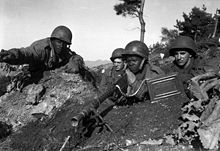 Soldiers from the U.S. 2nd Infantry Division in action near the Ch'ongch'on River, 20 November 1950
Soldiers from the U.S. 2nd Infantry Division in action near the Ch'ongch'on River, 20 November 1950
UN aerial reconnaissance had difficulty sighting PVA units in daytime, because their march and bivouac discipline minimized aerial detection.[21]:102 The PVA marched "dark-to-dark" (19:00–03:00), and aerial camouflage (concealing soldiers, pack animals, and equipment) was deployed by 05:30. Meanwhile, daylight advance parties scouted for the next bivouac site. During daylight activity or marching, soldiers were to remain motionless if an aircraft appeared, until it flew away;[21]:102 PVA officers were under order to shoot security violators. Such battlefield discipline allowed a three-division army to march the 286 miles (460 km) from An-tung, Manchuria to the combat zone in some 19 days. Another division night-marched a circuitous mountain route, averaging 18 miles (29 km) daily for 18 days.[29]
Meanwhile, on 10 October 1950, the 89th Tank Battalion was attached to the 1st Cavalry Division, increasing the armor available for the Northern Offensive. On 15 October, after moderate KPA resistance, the 7th Cavalry Regiment and Charlie Company, 70th Tank Battalion captured Namchonjam city. On 17 October, they flanked rightwards, away from the principal road (to Pyongyang), to capture Hwangju. Two days later, the 1st Cavalry Division captured Pyongyang, the North's capital city, on 19 October 1950.
On 15 October 1950, President Truman and General MacArthur met at Wake Island in the mid-Pacific Ocean. This meeting was much publicized because of the General's discourteous refusal to meet the President on the continental US.[21]:88 To President Truman, MacArthur speculated there was little risk of Chinese intervention in Korea,[21]:89 and that the PRC's opportunity for aiding the KPA had lapsed. He believed the PRC had some 300,000 soldiers in Manchuria, and some 100,000–125,000 soldiers at the Yalu River. He further concluded that, although half of those forces might cross south, "if the Chinese tried to get down to Pyongyang, there would be the greatest slaughter" without air force protection.[80][94]
 A column of the U.S. 1st Marine Division move through Chinese lines during their breakout from the Chosin Reservoir.
A column of the U.S. 1st Marine Division move through Chinese lines during their breakout from the Chosin Reservoir.
After secretly crossing the Yalu River on 19 October, the PVA 13th Army Group launched the First Phase Offensive on 25 October, attacking the advancing UN forces near the Sino-Korean border. After decimating the ROK II Corps at the Battle of Onjong, the first confrontation between Chinese and US military occurred on 1 November 1950; deep in North Korea, thousands of soldiers from the PVA 39th Army encircled and attacked the US 8th Cavalry Regiment with three-prong assaults—from the north, northwest, and west—and overran the defensive position flanks in the Battle of Unsan.[95] The surprise assault resulted in the UN forces retreating back to the Ch'ongch'on River, while the Chinese unexpectedly disappeared into mountain hideouts following victory. It is unclear why the Chinese did not press the attack and follow-up their victory.
The UN Command, however, were unconvinced that the Chinese had openly intervened due to the sudden Chinese withdrawal. On 24 November, the Home-by-Christmas Offensive was launched with the US Eighth Army advancing in northwest Korea, while the US X Corps were attacking along the Korean east coast. But the Chinese were waiting in ambush with their Second Phase Offensive.
On 25 November at the Korean western front, the PVA 13th Army Group attacked and over-ran the ROK II Corps at the Battle of the Ch'ongch'on River, and then decimated the US 2nd Infantry Division on the UN forces' right flank.[21]:98–9 The UN Command retreated; the US Eighth Army's retreat (the longest in US Army history)[96] was made possible because of the Turkish Brigade's successful, but very costly, rear-guard delaying action near Kunuri that slowed the PVA attack for two days (27–9 November). On 27 November at the Korean eastern front, a US 7th Infantry Division Regimental Combat Team (3,000 soldiers) and the US 1st Marine Division (12,000–15,000 marines) were unprepared for the PVA 9th Army Group's three-pronged encirclement tactics at the Battle of Chosin Reservoir, but they managed to escape under Air Force and X Corps support fire—albeit with some 15,000 collective casualties.[97]
By 30 November, the PVA 13th Army Group managed to expel the US Eighth Army from northwest Korea. Retreating from the north faster than they had counter-invaded, the Eighth Army crossed the 38th parallel border in mid December.[98]: 160 The UN morale hit rock bottom when commanding General Walton Walker of the US Eighth Army was killed on 23 December 1950 in an automobile accident.[21]:111 In the northeast Korea by 11 December, the US X Corps managed to cripple[99] the PVA 9th Army Group while establishing a defensive perimeter at the port city of Hungnam. The X Corps were forced to evacuate by 24 December in order to reinforce the badly depleted US Eighth Army to the south.[21]:104–11[98]:158
During the Hungnam evacuation, about 193 shiploads of UN Command forces and materiel (approximately 105,000 soldiers, 98,000 civilians, 17,500 vehicles, and 350,000 tons of supplies) were evacuated to Pusan.[21]:110 The SS Meredith Victory was noted for evacuating 14,000 refugees, the largest rescue operation by a single ship, even though it was designed to hold only 12 passengers. Before escaping, the UN Command forces razed most of Hungnam city, especially the port facilities;[80][100] and on 16 December 1950, President Truman declared a national emergency with Presidential Proclamation No. 2914, 3 C.F.R. 99 (1953),[101] which remained in force until 14 September 1978.[102]
Fighting around the 38th parallel (January – June 1951)
With Lieutenant-General Matthew Ridgway assuming the command of the US Eighth Army on 26 December, the PVA and the KPA launched their Third Phase Offensive (also known as the "Chinese New Year's Offensive") on New Year's Eve of 1950. Utilizing night attacks in which UN Command fighting positions were encircled and then assaulted by numerically superior troops who had the element of surprise. The attacks were accompanied by loud trumpets and gongs, which fulfilled the double purpose of facilitating tactical communication and mentally disorienting the enemy. UN forces initially had no familiarity with this tactic, and as a result some soldiers "bugged out," abandoning their weapons and retreating to the south.[21]:117 The Chinese New Year's Offensive overwhelmed UN forces, allowing the PVA and KPA to conquer Seoul for the second time on 4 January 1951.
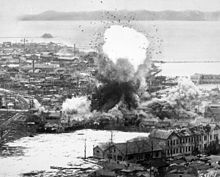 B-26 Invaders bomb logistics depots in Wonsan, North Korea, 1951
B-26 Invaders bomb logistics depots in Wonsan, North Korea, 1951
These setbacks prompted General MacArthur to consider using nuclear weapons against the Chinese or North Korean interiors, intending radioactive fallout zones would interrupt the Chinese supply chains.[103] However, upon the arrival of the charismatic General Ridgway, the esprit de corps of the bloodied Eighth Army immediately began to revive.[21]:113
UN forces retreated to Suwon in the west, Wonju in the center, and the territory north of Samcheok in the east, where the battlefront stabilized and held.[21]:117 The PVA had outrun its logistics capability and thus was forced to recoil from pressing the attack beyond Seoul;[21]:118 food, ammunition, and materiel were carried nightly, on foot and bicycle, from the border at the Yalu River to the three battle lines. In late January, upon finding that the PVA had abandoned their battle lines, General Ridgway ordered a reconnaissance-in-force, which became Operation Roundup (5 February 1951)[21]:121. A full-scale X Corps advance gradually proceeded while fully exploiting the UN Command's air superiority,[21]:120 concluded with the UN reaching the Han River and recapturing Wonju near Seoul.[21]:121
In mid-February, the PVA counterattacked with the Fourth Phase Offensive and achieved initial victory at Hoengseong. But the offensive was soon blunted by the IX Corps positions at Chipyong-ni in the center.[21]:121 Units of the US 2nd Infantry Division and the French Battalion fought a short but desperate battle that broke the attack's momentum.[21]:121 The battle is sometimes known as the Gettysburg of the Korean War. The battle saw 5,600 Korean, American and French defeat a numerically superior Chinese force. Surrounded on all sides, the US 2nd Infantry Division Warrior Division’s 23rd Regimental Combat Team with an attached French Battalion was hemmed in by more than 25,000 Chinese Communist Forces. United Nations Forces had previously retreated in the face of large Communist forces instead of getting cut off, but this time they stood and fought. The allies fought at odds of roughly 15 to 1.[104]
In the last two weeks of February 1951, Operation Roundup was followed by Operation Killer, carried out by the revitalized Eighth Army. It was a full-scale, battlefront-length attack staged for maximum exploitation of firepower to kill as many KPA and PVA troops as possible.[21]:121 Operation Killer concluded with I Corps re-occupying the territory south of the Han River, and IX Corps capturing Hoengseong.[21]:122 On 7 March 1951, the Eighth Army attacked with Operation Ripper, expelling the PVA and the KPA from Seoul on 14 March 1951. This was the city's fourth conquest in a years' time, leaving it a ruin; the 1.5 million pre-war population was down to 200,000, and people were suffering from severe food shortages.[21]:122[81]
On 1 March 1951 Mao sent a cable to Stalin, in which he emphasized the difficulties faced by Chinese forces and the urgent need for air cover, especially over supply lines. Apparently impressed by the Chinese war effort, Stalin finally agreed to supply two air force divisions, three anti-aircraft divisions, and six thousand trucks. PVA troops in Korea continued to suffer severe logistical problems throughout the war. In late April Peng Dehuai sent his deputy, Hong Xuezhi, to brief Zhou Enlai in Beijing. What Chinese soldiers feared, Hong said, was not the enemy, but that they had nothing to eat, no bullets to shoot, and no trucks to transport them to the rear when they were wounded. Zhou attempted to respond to the PVA's logistical concerns by increasing Chinese production and improving methods of supply, but these efforts were never completely sufficient. At the same time, large-scale air defense training programs were carried out, and the Chinese Air Force began to participate in the war from September 1951 onward.[105]
On 11 April 1951, Commander-in-Chief Truman relieved the controversial General MacArthur, the Supreme Commander in Korea.[21]:123–127 There were several reasons for the dismissal. MacArthur had crossed the 38th parallel in the mistaken belief that the Chinese would not enter the war, leading to major allied losses. He believed that whether or not to use nuclear weapons should be his own decision, not the President's.[106]:69 MacArthur threatened to destroy China unless it surrendered. While MacArthur felt total victory was the only honorable outcome, Truman was more pessimistic about his chances once involved in a land war in Asia, and felt a truce and orderly withdrawal from Korea could be a valid solution.[107] MacArthur was the subject of congressional hearings in May and June 1951, which determined that he had defied the orders of the President and thus had violated the US Constitution.[106]:79 A popular criticism of MacArthur was that he never spent a night in Korea, and directed the war from the safety of Tokyo.[108]
General Ridgway was appointed Supreme Commander, Korea; he regrouped the UN forces for successful counterattacks,[21]:127 while General James Van Fleet assumed command of the US Eighth Army.[21]:130 Further attacks slowly depleted the PVA and KPA forces; Operations Courageous (23–28 March 1951) and Tomahawk (23 March 1951) were a joint ground and airborne infilltration meant to trap Chinese forces between Kaesong and Seoul. UN forces advanced to "Line Kansas," north of the 38th parallel.[21]:131 The 187th Airborne Regimental Combat Team ("Rakkasans") second of two combat jumps were on Easter Sunday, 1951 at Munsan-ni, South Korea codenamed Operation Tomahawk. The mission was to get behind Chinese forces and block their movement north. The 60th Indian Parachute Field Ambulance provided the medical cover for the operations, dropping an ADS and a surgical team and treating over 400 battle casualties apart from the civilian casualties that formed the core of their objective as the unit was on a humanitarian mission.
The Chinese counterattacked in April 1951, with the Fifth Phase Offensive (also known as the "Chinese Spring Offensive") with three field armies (approximately 700,000 men).[21]:131[21]:132 The offensive's first thrust fell upon I Corps, which fiercely resisted in the Battle of the Imjin River (22–25 April 1951) and the Battle of Kapyong (22–25 April 1951), blunting the impetus of the offensive, which was halted at the "No-name Line" north of Seoul.[21]:133–134 On 15 May 1951, the Chinese commenced the second impulse of the Spring Offensive and attacked the ROK Army and the US X Corps in the east. After initial success, they were halted by 20 May.[21]:136–137 At month's end, the US Eighth Army counterattacked and regained "Line Kansas," just north of the 38th parallel.[21]:137–138 The UN's "Line Kansas" halt and subsequent offensive action stand-down began the stalemate that lasted until the armistice of 1953.
Stalemate (July 1951 – July 1953)
For the remainder of the Korean War the UN Command and the PVA fought, but exchanged little territory; the stalemate held. Large-scale bombing of North Korea continued, and protracted armistice negotiations began 10 July 1951 at Kaesong.[21]:175–7[21]:145 On the Chinese side, Zhou Enlai directed peace talks, and Li Kenong and Qiao Guanghua headed the negotiation team.[105] Combat continued while the belligerents negotiated; the UN Command forces' goal was to recapture all of South Korea and to avoid losing territory.[21]:159 The PVA and the KPA attempted similar operations, and later effected military and psychological operations in order to test the UN Command's resolve to continue the war.
The principal battles of the stalemate include the Battle of Bloody Ridge (18 August – 15 September 1951),[21]:160 the Battle of Heartbreak Ridge (13 September – 15 October 1951),[21]:161–2 the Battle of Old Baldy (26 June – 4 August 1952), the Battle of White Horse (6–15 October 1952), the Battle of Triangle Hill (14 October – 25 November 1952), the Battle of Hill Eerie (21 March – 21 June 1952), the sieges of Outpost Harry (10–8 June 1953), the Battle of the Hook (28–9 May 1953) and the Battle of Pork Chop Hill (23 March – 16 July 1953).
Chinese troops suffered from deficient military equipment, serious logistical problems, overextended communication and supply lines, and the constant threat of UN bombers. All of these factors generally led to a rate of Chinese casualties that was far greater than the casualties suffered by UN troops. The situation became so serious that, on November 1951, Zhou Enlai called a conference in Shenyang to discuss the PVA's logistical problems. "At the meeting it was decided to accelerate the construction of railways and airfields in the area, to increase the number of trucks available to the army, and to improve air defense by any means possible. These commitments did little to directly address the problems confronting PVA troops.[109]
In the months after the Shanyang conference Peng Dehuai went to Beijing several times to brief Mao and Zhou about the heavy casualties suffered by Chinese troops and the increasing difficulty of keeping the front lines supplied with basic necessities. Peng was convinced that the war would be protracted, and that neither side would be able to achieve victory in the foreseeable future. On 24 February 1952, the Military Commission, presided over by Zhou, discussed the PVA's logistical problems with members of various government agencies involved in the war effort. After the government representatives emphasized their inability to meet the demands of the war, Peng, in an angry outburst, shouted: "You have this and that problem... You should go to the front and see with your own eyes what food and clothing the soldiers have! Not to speak of the casualties! For what are they giving their lives? We have no aircraft. We have only a few guns. Transports are not protected. More and more soldiers are dying of starvation. Can't you overcome some of your difficulties?" The atmosphere became so tense that Zhou was forced to adjourn the conference. Zhou subsequently called a series of meetings, where it was agreed that the PVA would be divided into three groups, to be dispatched to Korea in shifts; to accelerate the training of Chinese pilots, to provide more anti-aircraft guns to the front lines; to purchase more military equipment and ammunition from the Soviet Union; to provide the army with more food and clothing; and, to transfer the responsibility of logistics to the central government.[110]
Armistice (July 1953 – November 1954)
The on again, off again armistice negotiations continued for two years,[21]:144–53 first at Kaesong (southern North Korea), then relocated at Panmunjom (bordering the Koreas).[21]:147 A major, problematic negotiation point was prisoner of war (POW) repatriation.[21]:187–99 The PVA, KPA, and UN Command could not agree on a system of repatriation because many PVA and KPA soldiers refused to be repatriated back to the north,[111] which was unacceptable to the Chinese and North Koreans.[21]:189–90 In the final armistice agreement, a Neutral Nations Repatriation Commission was set up to handle the matter.[21]:242–5[112]
In 1952 the US elected a new president, and on 29 November 1952, the president-elect, Dwight D. Eisenhower, went to Korea to learn what might end the Korean War.[21]:240 With the United Nations' acceptance of India's proposed Korean War armistice,[citation needed] the KPA, the PVA, and the UN Command ceased fire with the battle line approximately at the 38th parallel. Upon agreeing to the armistice, the belligerents established the Korean Demilitarized Zone (DMZ), which has since been patrolled by the KPA and ROKA, US, and Joint UN Commands.
The Demilitarized Zone runs northeast of the 38th parallel; to the south, it travels west. The old Korean capital city of Kaesong, site of the armistice negotiations, originally lay in the pre-war ROK, but now is in the DPRK. The United Nations Command, supported by the United States, the North Korean Korean People's Army, and the Chinese People's Volunteers, signed the Armistice Agreement on 27 July 1953 to end the fighting. The Armistice also called upon the governments of South Korea, North Korea, China and the United States to participate in continued peace talks. For his part, ROK President Rhee attacked the peace proceedings.[113] The war is considered to have ended at this point, even though there was no peace treaty.[9] North Korea nevertheless claims that it won the Korean War.[114][115]
After the war, Operation Glory (July–November 1954) was conducted to allow combatant countries to exchange their dead. The remains of 4,167 US Army and US Marine Corps dead were exchanged for 13,528 KPA and PVA dead, and 546 civilians dead in UN prisoner-of-war camps were delivered to the ROK government.[116] After Operation Glory, 416 Korean War unknown soldiers were buried in the National Memorial Cemetery of the Pacific (The Punchbowl), on the island of Oahu, Hawaii. Defense Prisoner of War/Missing Personnel Office (DPMO) records indicate that the PRC and the DPRK transmitted 1,394 names, of which 858 were correct. From 4,167 containers of returned remains, forensic examination identified 4,219 individuals. Of these, 2,944 were identified as American, and all but 416 were identified by name.[117] From 1996 to 2006, the DPRK recovered 220 remains near the Sino-Korean border.[118]
Division of Korea (1954–present)
See also: Division of Korea and Korean Demilitarized ZoneThe Korean Armistice Agreement provided for monitoring by an international commission. Since 1953, the Neutral Nations Supervisory Commission (NNSC) composed of members from the Swiss[119] and Swedish[120] Armed Forces has been stationed near the DMZ.
Since the armistice, there have been numerous incursions and acts of aggression by North Korea. In 1976, the axe murder incident was widely publicized. Since 1974, four incursion tunnels leading to Seoul have been uncovered. In 2010, a North Korean submarine torpedoed and sank the South Korean corvette ROKS Cheonan, resulting in the deaths of 46 sailors.[121] Again in 2010, North Korea fired artillery shells on Yeonpyeong island, killing two military personnel and two civilians.[122]
Characteristics
Casualties
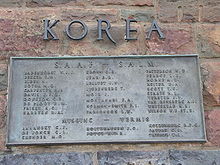 Korean War memorials are found in every UN Command Korean War participant country; this one is in Pretoria, South Africa.
Korean War memorials are found in every UN Command Korean War participant country; this one is in Pretoria, South Africa.
According to the data from the US Department of Defense, the United States had suffered 33,686 battle deaths, along with 2,830 non-battle deaths during the Korean War and 8,176 missing in action.[123] Western sources estimate the PVA had suffered between 100,000 to 1,500,000 deaths (most estimate some 400,000 killed), while the KPA had suffered between 214,000 to 520,000 deaths (most estimate some 500,000). Between some 245,000 to 415,000 South Korean civilian deaths were also suggested, and the entire civilian casualty during the war were estimated from 1,500,000 to 3,000,000 (most sources estimate some 2,000,000 killed).[124]
Data from official Chinese sources, on the other hand, reported that the PVA had suffered 114,000 battle deaths, 34,000 non-battle deaths, 340,000 wounded, 7,600 missing and 21,400 captured during the war. Among those captured, about 14,000 defected to Taiwan while the other 7,110 were repatriated to China.[125] Chinese sources also reported that North Korea had suffered 290,000 casualties, 90,000 captured and a "large" number of civilian deaths.[125] In return, the Chinese and North Koreans estimated that about 390,000 soldiers from United States, 660,000 soldiers from South Korea and 29,000 other UN soldiers were "eliminated" from the battlefield.[125]
Armored warfare
Initially, North Korean armor dominated the battlefield with Soviet T-34-85 medium tanks designed during the Second World War.[126] The KPA's tanks confronted a tankless ROK Army armed with few modern anti-tank weapons,[21]:39 including American World War II–model 2.36-inch (60 mm) M9 bazookas, effective only against the 45 mm side armor of the T-34-85 tank.[106]:25 The US forces arriving in Korea were equipped with light M24 Chaffee tanks (on occupation duty in nearby Japan) that also proved ineffective against the heavier KPA T-34 tanks.[106]:18
During the initial hours of warfare, some under-equipped ROK Army border units used American 105 mm howitzers as anti-tank guns to stop the tanks heading the KPA columns, firing high-explosive anti-tank ammunition (HEAT) over open sights to good effect; at the war's start, the ROK Army had 91 howitzers, but lost most to the invaders.[127]
Countering the initial combat imbalance, the UN Command reinforcement materiel included heavier US M4 Sherman, M26 Pershing, M46 Patton, and British Cromwell and Centurion tanks that proved effective against North Korean armor, ending its battlefield dominance.[21]:182–184 Unlike in the Second World War (1939–45), in which the tank proved a decisive weapon, the Korean War featured few large-scale tank battles. The mountainous, heavily forested terrain prevented large masses of tanks from maneuvering. In Korea, tanks served largely as infantry support and mobile artillery pieces.
Aerial warfare
Further information: MiG Alley, USAF Units and Aircraft of the Korean War, and Korean People's Air Force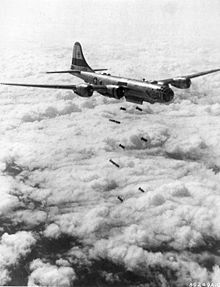 The KPAF shot down some 16 B-29 Superfortress bombers in the war.
The KPAF shot down some 16 B-29 Superfortress bombers in the war.
The Korean War was the first war in which jet aircraft played a central role. Once-formidable fighters such as the P-51 Mustang, F4U Corsair, and Hawker Sea Fury[21]:174—all piston-engined, propeller-driven, and designed during World War II—relinquished their air superiority roles to a new generation of faster, jet-powered fighters arriving in the theater. For the initial months of the war, the P-80 Shooting Star, F9F Panther, and other jets under the UN flag dominated North Korea's prop-driven air force of Soviet Yakovlev Yak-9 and Lavochkin La-9s. The balance would shift with the arrival of the swept wing Soviet MiG-15 Fagot.[21]:182[128]
The Chinese intervention in late October 1950 bolstered the Korean People's Air Force (KPAF) of North Korea with the MiG-15 Fagot, one of the world's most advanced jet fighters.[21]:182[129] The fast, heavily armed MiG outflew first-generation UN jets such as the American F-80 and Australian and British Gloster Meteors, posing a real threat to B-29 Superfortress bombers even under fighter escort.[129] Soviet Air Force pilots flew missions for the North to learn the West's aerial combat techniques. This direct Soviet participation is a casus belli that the UN Command deliberately overlooked, lest the war for the Korean peninsula expand, as the US initially feared, to include three communist countries—North Korea, the Soviet Union, and China—and so escalate to atomic warfare.[21]:182[130]
The USAF moved quickly to counter the MiG-15, with three squadrons of its most capable fighter, the F-86 Sabre, arriving in December 1950.[21]:183[131] Although the MiG's higher service ceiling—50,000 feet (15,000 m) vs. 42,000 feet (13,000 m)—could be advantageous at the start of a dogfight, in level flight, both swept wing designs attained comparable maximum speeds of around 660 mph (1,100 km/h). The MiG climbed faster, but the Sabre turned and dived better.[132] The MiG was armed with one 37 mm and two 23 mm cannons, while the Sabre carried six .50 caliber (12.7 mm) machine guns aimed with radar-ranged gunsights.
By early 1951, the battle lines were established and changed little until 1953. In summer and autumn 1951, the outnumbered Sabres of the USAF's 4th Fighter Interceptor Wing—only 44 at one point—continued seeking battle in MiG Alley, where the Yalu River marks the Chinese border, against Chinese and North Korean air forces capable of deploying some 500 aircraft. Following Colonel Harrison Thyng's communication with the Pentagon, the 51st Fighter-Interceptor Wing finally reinforced the beleaguered 4th Wing in December 1951; for the next year-and-a-half stretch of the war, aerial warfare continued.[133][clarification needed]
UN forces gradually gained air superiority in the Korean theater. This was decisive for the UN: first, for attacking into the peninsular north, and second, for resisting the Chinese intervention.[21]:182–184 North Korea and China also had jet-powered air forces; their limited training and experience made it strategically untenable to lose them against the better-trained UN air forces. Thus, the US and USSR fed materiel to the war, battling by proxy and finding themselves virtually matched, technologically, when the USAF deployed the F-86F against the MiG-15 late in 1952.
After the war, and to the present day, the USAF reports an F-86 Sabre kill ratio in excess of 10:1, with 792 MiG-15s and 108 other aircraft shot down by Sabres, and 78 Sabres lost to enemy fire.[134] An uncited alternative source claims only 379 Sabre kills.[citation needed] The Soviet Air Force reported some 1,100 air-to-air victories and 335 MiG combat losses, while China's People's Liberation Army Air Force (PLAAF) reported 231 combat losses, mostly MiG-15s, and 168 other aircraft lost. The KPAF reported no data, but the UN Command estimates some 200 KPAF aircraft lost in the war's first stage, and 70 additional aircraft after the Chinese intervention. The USAF disputes Soviet and Chinese claims of 650 and 211 downed F-86s, respectively, as more recent[when?] US figures state only 230 losses out of 674 F-86s deployed to Korea.[135] The differing tactical roles of the F-86 and MiG-15 may have contributed to the disparity in losses: MiG-15s primarily targeted B-29 bombers and ground-attack fighter-bombers, while F-86s targeted the MiGs.
The Korean War marked a major milestone not only for fixed-wing aircraft, but also for rotorcraft, featuring the first large-scale deployment of helicopters for medical evacuation (medevac).[136][137] In 1944–1945, during the Second World War, the YR-4 helicopter saw limited ambulance duty, but in Korea, where rough terrain trumped the jeep as a speedy medevac vehicle,[138] helicopters like the Sikorsky H-19 helped reduce fatal casualties to a dramatic degree when combined with complementary medical innovations such as Mobile Army Surgical Hospitals.[139][140] The limitations of jet aircraft for close air support highlighted the helicopter's potential in the role, leading to development of the AH-1 Cobra and other helicopter gunships used in the Vietnam War (1965–75).[136]
Bombing North Korea
On 12 August 1950 the USAF dropped 625 tons of bombs on North Korea; two weeks later, the daily tonnage increased to some 800 tons.[141] Bruce Cummings, a historian at the University of Chicago, has said that U.S. warplanes dropped more napalm and bombs on North Korea than they did during the whole pacific campaign of WW2.[142]
As a result, eighteen of North Korea's cities were more than 50% destroyed. The war's highest-ranking American POW, US Major General William F. Dean,[143] reported that most of the North Korean cities and villages he saw were either ruins or snow-covered wastelands.[144]
As well as conventional bombing, the Communist side claimed that the USA had used biological weapons.[145]
Naval engagements of the Korean War (1950–53) and post-armistice incidentsPre Armistice
Korea Strait · Chumonchin Chan · Haeju · Inchon · Operation Wonsan · Operation Tailboard · Wonsan · Operation Fireball · Buzz Saw · Operation Kickoff · USS Walke Incident · Han RiverPost Armistice
Gangneung Incident (1996) · Yosu (1998) · Maritime border incidents (1999– ) · First Yeonpyeong (1999) · Second Yeonpyeong (2002) · Daecheong (2009) · Cheonan sinking (2010) To disrupt North Korean communications, the USS Missouri fires a salvo from its 16-inch guns at shore targets near Chongjin, North Korea, 21 October 1950
To disrupt North Korean communications, the USS Missouri fires a salvo from its 16-inch guns at shore targets near Chongjin, North Korea, 21 October 1950
Because neither Korea had a large navy, the Korean War featured few naval battles; mostly the combatant navies served as naval artillery for their in-country armies. A skirmish between North Korea and the UN Command occurred on 2 July 1950; the US Navy cruiser USS Juneau, the Royal Navy cruiser HMS Jamaica, and the frigate HMS Black Swan fought four North Korean torpedo boats and two mortar gunboats, and sank them.
During most of the war, the UN navies patrolled the west and east coasts of North Korea and sank supply and ammunition ships to deny the sea to North Korea. Aside from very occasional gunfire from North Korean shore batteries, the main threat to US and UN navy ships was from magnetic mines the North Koreans employed for defensive purposes.
The USS Juneau sank ammunition ships that had been present in her previous battle. The last sea battle of the Korean War occurred at Inchon, days before the Battle of Incheon; the ROK ship PC 703 sank a North Korean mine layer in the Battle of Haeju Island, near Inchon. Three other supply ships were sunk by PC-703 two days later in the Yellow Sea.[47]
U.S. threat of atomic warfare
On 5 April 1950, the Joint Chiefs of Staff (JCS) issued orders for the retaliatory atomic bombing of Manchurian PRC military bases, if either their armies crossed into Korea or if PRC or KPA bombers attacked Korea from there. The President ordered the transfer of nine Mark 4 nuclear bombs "to the Air Force's Ninth Bomb Group, the designated carrier of the weapons ... [and] signed an order to use them against Chinese and Korean targets", which he never transmitted.[146]
President Truman did not immediately threaten nuclear warfare after the October 1950 Chinese intervention, but, 45 days later, remarked about the possibility of using it after the PVA repelled the UN Command from North Korea.
In The Origins of the Korean War (1981, 1990), US historian Bruce Cumings reports that in a 30 November 1950 press conference, President Truman's allusions to attacking the KPA with nuclear weapons "was a threat based on contingency planning to use the bomb, rather than the faux pas so many assumed it to be." On 30 November 1950, the USAF Strategic Air Command was ordered to "augment its capacities, and that this should include atomic capabilities."
The Indian Ambassador, K. Madhava Panikkar, reports "that Truman announced that he was thinking of using the atom bomb in Korea. But the Chinese seemed totally unmoved by this threat ... The propaganda against American aggression was stepped up. The 'Aid Korea to resist America' campaign was made the slogan for increased production, greater national integration, and more rigid control over anti-national activities. One could not help feeling that Truman's threat came in very useful to the leaders of the Revolution, to enable them to keep up the tempo of their activities."[80][147][148]
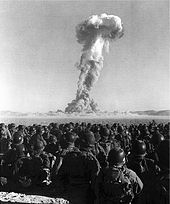 Atom bomb test, 1951. This was the Operation Buster-Jangle Dog shot, on 1 November.
Atom bomb test, 1951. This was the Operation Buster-Jangle Dog shot, on 1 November.
President Truman remarked that his government was actively considering using the atomic bomb to end the war in Korea but that only he—the US President—commanded atomic bomb use, and that he had not given authorization. The matter of atomic warfare was solely a US decision, not the collective decision of the UN. Truman met on 4 December 1950 with UK prime minister and Commonwealth spokesman Clement Attlee, French Premier René Pleven, and Foreign Minister Robert Schuman to discuss their worries about atomic warfare and its likely continental expansion. The US's forgoing atomic warfare was not because of "a disinclination by the USSR and PRC to escalate" the Korean War, but because UN allies—notably from the UK, the Commonwealth, and France—were concerned about a geopolitical imbalance rendering NATO defenseless while the US fought China, who then might persuade the USSR to conquer Western Europe.[80][149]
On 6 December 1950, after the Chinese intervention repelled the UN Command armies from northern North Korea, General J. Lawton Collins (Army Chief of Staff), General MacArthur, Admiral C. Turner Joy, General George E. Stratemeyer, and staff officers Major General Doyle Hickey, Major General Charles A. Willoughby, and Major General Edwin K. Wright, met in Tokyo to plan strategy countering the Chinese intervention; they considered three potential atomic warfare scenarios encompassinging the next weeks and months of warfare.[80]
- In the first scenario: If the PVA continued attacking in full and the UN Command is forbidden to blockade and bomb China, and without Nationalist Chinese reinforcements, and without an increase in US forces until April 1951 (four National Guard divisions were due to arrive), then atomic bombs might be used in North Korea.[80]
- In the second scenario: If the PVA continued full attacks and the UN Command have blockaded China and have effective aerial reconnaissance and bombing of the Chinese interior, and the Nationalist Chinese soldiers are maximally exploited, and tactical atomic bombing is to hand, then the UN forces could hold positions deep in North Korea.[80]
- In the third scenario: if the PRC agreed to not cross the 38th parallel border, General MacArthur recommended UN acceptance of an armistice disallowing PVA and KPA troops south of the parallel, and requiring PVA and KPA guerrillas to withdraw northwards. The US Eighth Army would remain to protect the Seoul–Incheon area, while X Corps would retreat to Pusan. A UN commission should supervise implementation of the armistice.[80]
In 1951, the US escalated closest to atomic warfare in Korea. Because the PRC had deployed new armies to the Sino-Korean frontier, pit crews at the Kadena Air Base, Okinawa, assembled atomic bombs for Korean warfare, "lacking only the essential pit nuclear cores." In October 1951, the US effected Operation Hudson Harbor to establish nuclear weapons capability. USAF B-29 bombers practised individual bombing runs from Okinawa to North Korea (using dummy nuclear or conventional bombs), coordinated from Yokota Air Base in east-central Japan. Hudson Harbor tested "actual functioning of all activities which would be involved in an atomic strike, including weapons assembly and testing, leading, ground control of bomb aiming". The bombing run data indicated that atomic bombs would be tactically ineffective against massed infantry, because the "timely identification of large masses of enemy troops was extremely rare."[150][151][152][153][154]
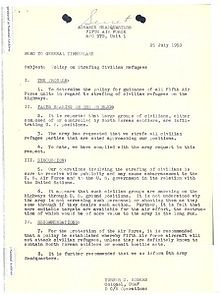 MEMO (25 Jul ’50) to Gen. Timberlake, USAF; SUBJECT: Policy on Strafing Civilian Refugees:
MEMO (25 Jul ’50) to Gen. Timberlake, USAF; SUBJECT: Policy on Strafing Civilian Refugees:
It is reported that large groups of civilians, either composed of or controlled by North Korean soldiers, are infiltrating US positions. The army has requested we strafe all civilian refugee parties approaching our positions. To date, we have complied with the army request in this respect.War crimes
Civilian deaths and massacres
Further information: Hangang Bridge bombing, Yongsan bombing, No Gun Ri Massacre, Geochang massacre, Sancheong-Hamyang massacre, and Ganghwa massacreIn occupied areas, North Korean Army political officers purged South Korean society of its intelligentsia by assassinating every educated person—academic, governmental, religious—who might lead resistance against the North; the purges continued during the NPA retreat.[155] Immediately after the invasion in June 1950 the South Korean Government ordered the nation-wide "pre-emptive apprehension" of politically suspect or disloyal citizens.
The military police and right-wing paramilitary (civilian) armies executed thousands of left-wing and communist political prisoners at Daejeon Prison and in the Jeju Uprising (1948–49).[156] The Americans on the island documented the events, but never intervened.[48]
US diplomat Gregory Henderson, then in Korea, calculates some 100,000 pro-North political prisoners were killed and buried in mass graves.[157] The South Korean Truth and Reconciliation Commission has compiled reports of hundreds of thousands of civilian killings before and during the war.[158]
In addition to conventional military operations, North Korean soldiers fought the UN forces by infiltrating guerrillas among refugees. These soldiers disguised as refugees would approach UN forces asking for food and help, then open fire and attack. US troops acted under a "shoot-first-ask-questions-later" policy against any civilian refugee approaching US battlefield positions,[159] a policy that led US Soldiers to kill between 8 and 400[dubious ] civilians at No Gun Ri (26–29 July 1950) in central Korea because they believed some of the refugees killed to be North Korean soldiers in disguise.[160]
The Korean armies forcibly conscripted available civilian men and women to their war efforts. In Statistics of Democide (1997), Prof. R. J. Rummel reports that the North Korean Army conscripted some 400,000 South Korean citizens.[155] The South Korean Government reported that the North abducted some 83,000 citizens before the US recaptured Seoul in September 1950; the North says they defected.[161][162]
Bodo League anti–communist massacre
Main article: Bodo League massacreTo outmaneuver a possible fifth column in the Republic of Korea, President Syngman Rhee's régime assassinated its "enemies of the state"—South Koreans who are allegedly communists, pro-North Korea, or leftist—by first imprisoning them for political re-education in the Gukmin Bodo Ryeonmaeng (National Rehabilitation and Guidance League, also known as the Bodo League). The true purpose of the anti–communist Bodo League, abetted by the United States Army Military Government in Korea (USAMGIK), was the régime's assassination of some 10,000 to 100,000 "enemies of the state" whom they dumped in trenches, mines, and the sea, before and after the 25 June 1950 North Korean invasion. Contemporary calculations report some 200,000 to 1,200,000.[clarification needed][163] USAMGIK officers were present at one political execution site; at least one US officer sanctioned the mass killings of political prisoners whom the North Koreans would have freed after conquering the peninsular south.[164]
The South Korean Truth and Reconciliation Commission reports that petitions requesting explanation of the summary execution of leftist South Koreans outnumber, six-to-one, the petitions requesting explanation of the summary execution of rightist South Koreans.[165] These data apply solely to South Korea, because North Korea is not integral to the Truth and Reconciliation Commission. The father of Bodo League massacre survivor Kim Jong-chol was press-ganged to work with the KPA and later executed by the Rhee Government as a collaborator; his grandparents and a seven-year-old sister also were assassinated. About his experience in Namyangju city, he says:
“ Young children or whatever, were all killed en masse. What did the family do wrong? Why did they kill the family? When the people from the other side [North Korea] came here, they didn't kill many people. ” — Kim Jong-chol[164]USAMGIK officers photographed the mass killings at Daejon city in central South Korea, where the Truth Commission believe some 3,000 to 7,000 people were shot and buried in mass graves in early July 1950. Other declassified records report that a US Army Lieutenant Colonel approved the assassination of 3,500 political prisoners by the ROK Army unit to which he was military advisor when the KPA reached the southern port city of Pusan.[164] US diplomats reported having urged the Rhee régime's restraint against its political opponents, and that the USAMGIK, who formally controlled the peninsular south, did not halt the mass assassinations.[164]
Prisoners of war
See also: Korean POWs detained in North Korea and Hill 303 massacreThe US reported that North Korea mistreated prisoners of war: soldiers were beaten, starved, put to forced labor, marched to death, and summarily executed.[166][167]
The KPA killed POWs at the battles for Hill 312, Hill 303, the Pusan Perimeter, and Daejeon—discovered during early after-battle mop-up actions by the UN forces. Later, a US Congress war crimes investigation, the United States Senate Subcommittee on Korean War Atrocities of the Permanent Subcommittee of the Investigations of the Committee on Government Operations reported that "... two-thirds of all American prisoners of war in Korea died as a result of war crimes".[168][169][170]
Although the Chinese rarely executed prisoners like their Korean counterparts, mass starvation and diseases swept through the Chinese run POW camps during the winter of 1950–51. About 43 percent of all US POWs died during this period. The Chinese defended their actions by stating that all Chinese soldiers during this period were suffering mass starvation and diseases due to the lack of competent logistics system. The UN POWs, however, disputed the claim by pointing out that most of the Chinese camps were located near the easily supplied Sino-Korean border, and that starvation was used to force the prisoners to accept the communism indoctrinations programs, which were running in full swing after the starvation was over.[171]
The North Korean Government reported some 70,000 ROK Army POWs; 8,000 were repatriated. South Korea repatriated 76,000 Korean People's Army POWs.[172] Besides the 12,000 UN Command forces POWs dead in captivity, the KPA might have press-ganged some 50,000 ROK POWs into the North Korean military.[155] Per the South Korean Ministry of Defense, there remained some 560 Korean POWs detained in North Korea in 2008; from 1994 until 2009, some 79 ROK POWs escaped the North.[173][174]
The North Korean Government denied having POWs from the Korean War, and, via the Korean Central News Agency, reported that the UN forces killed some 33,600 KPA POWs; that on 19 July 1951, in POW Camp No. 62, some 100 POWs were killed as machine-gunnery targets; that on 27 May 1952, in the 77th Camp, Koje Island (now in Geoje), the ROK Army incinerated with flamethrowers some 800 KPA POWs who rejected "voluntary repatriation" south, and instead demanded repatriation north.[175]
Starvation
See also: National Defense Corps IncidentIn December 1950, National Defense Corps was founded, the soldiers were 406,000 drafted citizens.[176] In the winter of 1951, 50,000[177][178] to 90,000[179][180] South Korean National Defense Corps soldiers starved to death while marching southward under the Chinese offensive when their commanding officers embezzled funds earmarked for their food.[177][179][181][182] This event is called the National Defense Corps Incident.[177][179]
Aftermath
Main article: Aftermath of the Korean War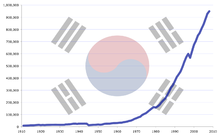 The South Korean economy grew almost non-stop from near zero to over a trillion dollars in less than half a century.
The South Korean economy grew almost non-stop from near zero to over a trillion dollars in less than half a century.
Effect on China
Mao Zedong's decision to involve China in the Korean War was a conscientious effort to confront the most powerful country in the world, undertaken at a time when the regime was still consolidating its own power after winning the Chinese Civil War. Mao primarily supported intervention not to save North Korea or to appease the Soviet Union, but because he believed that a military conflict with the United States was inevitable after UN forces crossed the 38th parallel. A secondary motive of Mao's was to improve his own prestige inside the communist international community by demonstrating that his Marxist concerns were international. In his later years Mao believed that Stalin only gained a positive opinion of him after China's entrance into the Korean War. Inside China, the war improved the long-term prestige of Mao, Zhou, and Peng.[183]
China emerged from the Korean War united by a sense of national pride, despite the war's enormous costs. The Chinese people were educated to believe that the war was initiated by the United States and Korea, and not by a fraternal communist state in the north. In Chinese propaganda, the Chinese war effort was portrayed and accepted as an example of China's engaging the strongest power in the world with an under-equipped army, forcing it to retreat, and fighting it to a military stalemate. These successes were contrasted with China's historical humiliations by Japan and by Western powers over the previous hundred years in order to promote the image of the PLA and the CCP. The most significant negative long-term consequence of the war (for China) was that it led the United States to guarantee the safety of Chiang Kai-shek's regime in Taiwan, effectively ensuring that Taiwan would remain outside of PRC control until the present day.[183]
Defection
Operation Moolah was a USAF effort during the Korean War to capture a fully mission capable Soviet MiG-15.[184][185] The MiG-15 was introduced by Communist forces on 1 November 1950 over the skies of Korea.[186] USAF pilots would later report that the performance of the MiG-15 was superior against all United Nations (U.N.) aircraft, including the USAF's newest plane, the F-86 Sabre.[187] The operation focused on influencing Communist pilots to defect to South Korea with a fully mission capable MiG for a financial award and political freedom. The success of the operation is disputable since not a single Communist pilot defected before the armistice was signed on 27 July 1953. But on 21 September 1953, Lieutenant (LT) No Kum-Sok flew his MiG-15 to the Kimpo Air Base, South Korea unaware of Operation Moolah.[188]
Proxy war
The Korean War (1950–53) was the first major proxy war in the Cold War (1945–91), the prototype of the following sphere-of-influence wars such as the Vietnam War (1959–75). The Korean War established proxy war as one way that the nuclear superpowers indirectly conducted their rivalry in third-party countries. The NSC-68 Containment Policy extended the cold war from occupied Europe to the rest of the world.[citation needed]
DMZ
Fighting ended at the 38th parallel and the Korean Demilitarized Zone, a strip of land 248x4 km (155x2.5 mi), now divides the two countries. Even so, skirmishes, incursions, and incidents between the combatants have continued since the Armistice was signed.
Racial integration of U.S. Forces
The beginning of racial integration efforts in the U.S. military began during the Korean War, where African Americans fought in integrated units for the first time. Among the 1.8 million American soldiers who fought in the Korean War there were more than 100,000 African Americans.[189]
Turkey
The Korean War affected other participant combatants. Turkey, for example, entered NATO in 1952[190] and a foundation of bilateral diplomatic and trade relations was enhanced.[191]
Post-war economies
Post-war recovery was different in the two Koreas. South Korea stagnated in the first post-war decade, but later industrialized and modernized. Contemporary North Korea remains underdeveloped. South Korea had one of the world's fastest growing economies from the early 1960s to the late 1990s. In 1957 South Korea had a lower per capita GDP than Ghana,[192] and by 2008 it was 17 times as high as Ghana's.[193] The economy of South Korea is a modern free market economy, and South Korea is a member of the Organisation for Economic Co-operation and Development (OECD) and G-20 groups.
In the 1990s North Korea faced significant economic disruptions. The North Korean famine is believed to have killed as many as 2.5 million people.[194] The CIA World Factbook estimates North Korea's GDP (Purchasing power parity (PPP)) is $40 billion, which is 3.0% of South Korea's $1.196 trillion GDP (PPP). North Korean personal income is $1,800 per capita, which is 7.0% of the South Korean $24,500 per capita income.
ROK Anti-communism
Anti-communism remains in ROK politics. The Uri Party practiced a "Sunshine Policy" towards North Korea; the US often disagreed with the Uri Party and (former) ROK President Roh about relations between the Koreas. The conservative Grand National Party (GNP), the Uri Party's principal opponent, is anti-North Korea.[citation needed]
ROK Anti-Americanism sentiments
Korean anti-Americanism after the war was fueled by the presence and behavior of American military personnel (USFK) and U.S. support for authoritarian regime, a fact still evident during the country's democratic transition in the 1980s.[195] In a February 2002 Gallup-Korea poll, only one-third of South Koreans viewed the United States favorably.[196]
"G.I. Babies" and U.S. immigration law
In addition a large number of mixed race ‘G.I. babies’ (offspring of U.S. and other western soldiers and Korean women) were filling up the country’s orphanages. Korean traditional society places significant weight on paternal family ties, bloodlines, and purity of race. Children of mixed race or those without fathers are not easily accepted in Korean society. Thousands were adopted by American families in the years following the war, when their plight was covered on television.[197]
The U.S. Immigration Act of 1952 removed race as a limiting factor in immigration, and made possible the entry of military spouses and children from South Korea after the Korean War. With the passage of the Immigration Act of 1965, which substantially changed U.S. immigration policy toward non-Europeans, Koreans became one of the fastest growing Asian groups in the United States.[198]
Popular culture
Main article: Korean War in popular cultureThe Korean War has been the subject of films and books, and has been depicted in other media such as theatre and photography. The TV series M*A*S*H is one well known example. The 1959 novel The Manchurian Candidate has twice been made into films. The 1982 film Inchon depicted the invasion at Inchon. Many films about the war have been produced in Asian countries as well.
See also
- Military history of Australia during the Korean War
- Pyongyang Sally
- Korean DMZ Conflict (1966–1969)
- Philippine Expeditionary Forces To Korea
- UNCMAC—the UN Command Military Armistice Commission operating from 1953 to the present
- UNCURK—the 1951 UN Commission for the Unification and Rehabilitation of Korea
- UNTCOK—the 1950 United Nations Temporary Commission on Korea
- Vietnam War
- War Memorial of Korea
- South African Air Force
Notes
- ^ "Předplatné LN". Lidovky.cz. 2011-05-18. http://www.lidovky.cz/cesi-v-korejske-valce-05n-/ln_noviny.asp?c=A100625_100008_ln_noviny_sko&klic=237661&mes=100625_1. Retrieved 2011-11-07.
- ^ "Cinnost CSLA za valky v Koreji... | Ross Hedvicek ... Nastenka AgitProp". Hedvicek.blog.cz. 1953-07-27. http://hedvicek.blog.cz/0902/cinnost-csla-za-valky-v-koreji. Retrieved 2011-11-07.
- ^ a b c d e f g h i j k l m n o p q r s t u v w x y z aa ab ac ad ae af ag ah ai aj ak al am an ao ap aq ar "Casualties of Korean War". Ministry of National Defense of Republic of Korea. http://www.imhc.mil.kr/imhcroot/data/korea_view.jsp?seq=4&page=1. Retrieved 14 February 2007.
- ^ a b Hickey, Michael. "The Korean War: An Overview". http://www.bbc.co.uk/history/worldwars/coldwar/korea_hickey_04.shtml. Retrieved 16 August 2007.
- ^ Chen, Hui; Hao Yan (26 October 2010). "183108:抗美援朝纪念馆公布朝鲜战争志愿军牺牲人数" (in Chinese). Xinhuanet. Xinhua News Agency. http://news.xinhuanet.com/politics/2010-10/26/c_12704233.htm. Retrieved 26 October 2010.
- ^ Yang, Tiehu (27 June 2010). "徐焰少将:中国抗美援朝牺牲18万人" (in Chinese). People's Daily Online. http://society.people.com.cn/GB/86800/11980044.html. Retrieved 26 October 2010.
- ^ Xu, Yan. "Korean War: In the View of Cost-effectiveness". Consulate-General of the People's Republic of China in New York. http://www.nyconsulate.prchina.org/eng/xw/t31430.htm. Retrieved 16 August 2007.
- ^ Кривошеев Г. Ф., Россия и СССР в войнах XX века: потери вооруженных сил. Статистическое исследование (Krivosheev G. F., Russia and the USSR in the wars of the 20th century: losses of the Armed Forces. A Statistical Study Greenhill 1997 ISBN 1-85367-280-7)(Russian)
- ^ a b "US State Department statement regarding "Korea: Neutral Nations Supervisory Commission" and the Armistice Agreement "which ended the Korean War."". FAS. http://www.fas.org/news/dprk/1995/950313-dprk-usia.htm. Retrieved 4 January 2011.
- ^ Boose, Donald W (Winter 1995–96), "Portentous Sideshow: The Korean Occupation Decision", Parameters, 5, US Army War College, pp. 112–29, OCLC 227845188
- ^ a b Devine, Robert A.; Breen, TH; Frederickson, George M; Williams, R Hal; Gross, Adriela J; Brands, HW (2007). America Past and Present. II: Since 1865 (8th ed.). Pearson Longman. pp. 819–21. ISBN 0-321-44661-5.
- ^ a b Hermes, Jr., Walter (2002) [1966]. Truce Tent and Fighting Front. United States Army in the Korean War. United States Army Center of Military History. pp. 2, 6–9. http://www.history.army.mil/books/korea/truce/fm.htm.
- ^ "The President's News Conference of June 29, 1950". Teachingamericanhistory.org. 29 June 1950. http://teachingamericanhistory.org/library/index.asp?document=594. Retrieved 4 January 2011.
- ^ "Remembering the Forgotten War: Korea, 1950–1953". Naval Historical Center. http://www.history.navy.mil/ac/korea/korea1.htm. Retrieved 16 August 2007.
- ^ Halberstam, David (2007). The Coldest Winter: America and the Korean War. New York: Disney Hyperion. p. 2. ISBN 978-1-4013-0052-4. "Over half a century later, the war still remained largely outside American political and cultural consciousness. The Forgotten War was the apt title of one of the best books on it. Korea was a war that sometimes seemed to have been orphaned by history."
- ^ Military.com Korean War: The Forgotten War. Overview.
- ^ Keith L. Pratt, et. al., Korea, a Historical and Cultural Dictionary (Richmond, Surrey: Curzon Press, 1999), p. 239.
- ^ Ilpyong J. Kim, Historical Dictionary of North Korea (Scarecrow Press, 2003), p. 79
- ^ "War to Resist U.S. Aggression and Aid Korea Commemorated in Henan". China Radio International. 25 October 2008. http://english.cri.cn/2946/2008/10/25/195s417906.htm. Retrieved 29 January 2010.
- ^ "War to Resist US Aggression and Aid Korea Marked in DPRK". Xinhua. 26 October 2000. http://www.china.org.cn/e-America/actives/dprk.htm. Retrieved 29 January 2010.
- ^ a b c d e f g h i j k l m n o p q r s t u v w x y z aa ab ac ad ae af ag ah ai aj ak al am an ao ap aq ar as at au av aw ax ay az ba bb bc bd be bf bg bh bi bj bk bl bm bn bo bp bq br bs bt bu bv bw bx by bz ca cb cc cd ce cf cg ch Stokesbury, James L (1990). A Short History of the Korean War. New York: Harper Perennial. ISBN 0688095135.
- ^ a b c Schnabel, James F. "United States Army in the Korean War, Policy and Direction: The First Year". pp. 3, 18. http://www.history.army.mil/books/P&D.HTM. Retrieved 19 August 2007.
- ^ "Treaty of Annexation (Annexation of Korea by Japan)". USC-UCLA Joint East Asian Studies Center. http://www.isop.ucla.edu/eas/documents/kore1910.htm. Retrieved 19 August 2007.
- ^ a b c Dear, Ian; Foot, M.R.D. (1995). The Oxford Companion to World War II. Oxford, New York: Oxford University Press. p. 516. ISBN 0198662254.
- ^ Cairo Communiqué. National Diet Library, Japan. http://www.ndl.go.jp/constitution/e/shiryo/01/002_46/002_46tx.html
- ^ a b c Goulden, Joseph C (1983). Korea: The Untold Story of the War. McGraw-Hill. p. 17. ISBN 0070235805.
- ^ Whelan, Richard (1991). Drawing the Line: the Korean War 1950–53. Boston: Little, Brown and Company. p. 22. ISBN 0316934038.
- ^ McCullough, David (1992). Truman. Simon & Schuster Paperbacks. pp. 785, 786. ISBN 0671869205.
- ^ a b c d e f g h i j Appleman, Roy E (1998) [1961]. South to the Naktong, North to the Yalu. United States Army Center of Military History. pp. 3, 15, 381, 545, 771, 719. ISBN 0160019184. http://www.history.army.mil/books/korea/20-2-1/toc.htm.
- ^ McCune, Shannon C (1946-05). "Physical Basis for Korean Boundaries". Far Eastern Quarterly May 1946 (5): 286–7
- ^ Grajdanzev, Andrew (1945-10). "Korea Divided". Far Eastern Survey XIV: 282
- ^ Grajdanzev, Andrew. History of Occupation of Korea. I. p. 16
- ^ a b c Chen 1994, p 110.
- ^ Chen 1994, pp 110–111.
- ^ Chen 1994, p 111.
- ^ Chen 1994, pp 110, 162.
- ^ Chen 1994, p 26.
- ^ Chen 1994, p 22.
- ^ Chen 1994, p 41.
- ^ Chen 1994, p 21.
- ^ Chen 1994, p 19.
- ^ Chen 1994, pp 25–26, 93.
- ^ Cumings, Bruce (1981). Origins of the Korean War. Princeton University Press. ISBN 89-7696-612-0.
- ^ Becker, Jasper (2005). Rogue Regime: Kim Jong Il and the Looming Threat of North Korea. New York: Oxford University Press. p. 52. ISBN 019517044X.
- ^ Halberstam, David (2007). The Coldest Winter: America and the Korean War. New York: Disney Hyperion. ISBN 978-1-4013-0052-4.
- ^ Becker, Jasper (2005). Rogue Regime: Kim Jong Il and the Looming Threat of North Korea. New York: Oxford University Press, USA. p. 53. ISBN 019517044X.
- ^ a b Cumings, Bruce (1981). "3, 4". Origins of the Korean War. Princeton University Press. ISBN 89-7696-612-0.
- ^ a b "Ghosts Of Cheju". News week. 19 June 2000. http://www.newsweek.com/2000/06/18/ghosts-of-cheju.html. Retrieved 16 July 2010.
- ^ "Korea: For Freedom". TIME. 20 May 1946. http://www.time.com/time/magazine/article/0,9171,792877-1,00.html. Retrieved 10 December 2008. "Rightist groups in the American zone, loosely amalgamated in the Representative Democratic Council under elder statesman Syngman Rhee, protested heatedly ..."
- ^ "The Failure of Trusteeship". infoKorea. http://myhome.shinbiro.com/~mss1/failure.html. Retrieved 10 December 2008.
- ^ "Korea Notes from Memoirs by Harry S. Truman". The US War Against Asia (notes). III Publishing. http://www.mcn.org/e/iii/politics/asian_war/korea_truman_notes.html. Retrieved 10 December 2008. "U.S. proposed general elections (U.S. style) but Russia insisted on Moscow Agreement."[dead link]
- ^ The Korean War, 1950–1953, Carter Malkasian, Fitzroy Dearborn Publishers, 2001, ISBN 1579583644, p.13
- ^ Stueck, William (2004). The Korean War in world history. Univ Pr of Kentucky. p. 38. ISBN 0813123062. http://books.google.com/?id=9yqLZUITEI0C&pg=PA38&dq=USAMGIK+First+Republic+election+600&q=USAMGIK%20First%20Republic%20election%20600.
- ^ a b "The Korean War, The US and Soviet Union in Korea". MacroHistory. http://www.fsmitha.com/h2/ch24kor.html. Retrieved 19 August 2007.
- ^ a b Richard W. Stewart, ed (2005). "The Korean War, 1950–1953". American Military History, Volume 2. United States Army Center of Military History. CMH Pub 30-22. http://www.history.army.mil/books/AMH-V2/AMH%20V2/chapter8.htm. Retrieved 20 August 2007.
- ^ 白桦 (2010年 6月 26日). "韩战无赢家 中苏北韩领袖策划战争 [No winner in the Korean War, Soviet war plans North Korea leader]" (in Chinese). Voice of America. http://www1.voanews.com/chinese/news/20100626-Korean-war-97220239.html?refresh=1. Retrieved 27 June 2010.
- ^ Dennis Wainstock, Truman, MacArthur, and the Korean War (1999) p. 137
- ^ "439 civilians confirmed dead in Yeosu-Suncheon Uprising of 1948 New report by the Truth Commission places blame on Syngman Rhee and the Defense Ministry, advises government apology". Hankyoreh. 8 January 2009. http://english.hani.co.kr/arti/english_edition/e_national/332032.html. Retrieved 16 July 2010.
- ^ "'문경학살사건' 유족 항소심도 패소". Chosun Ilbo. 6 August 2009. http://www.chosun.com/site/data/html_dir/2009/08/06/2009080600689.html. Retrieved 16 July 2010.(Korean)
"두 민간인 학살 사건, 상반된 판결 왜 나왔나?'울산보도연맹' – '문경학살사건' 판결문 비교분석해 봤더니...". OhmyNews. 17 February 2009. http://www.ohmynews.com/NWS_Web/view/at_pg.aspx?CNTN_CD=A0001070694. Retrieved 16 July 2010.(Korean) - ^ Barnouin and Yu 139–140
- ^ Gup, Ted (2000). The Book of Honor: Cover Lives and Classified Deaths at the CIA.[page needed]
- ^ "만물상 6•25 한강다리 폭파의 희생자들". Chosun Ilbo. 29 June 2010. http://news.chosun.com/site/data/html_dir/2010/06/29/2010062902370.html. Retrieved 15 July 2010.
"60년 만에 만나는 한국의 신들러들" (in Korean). Hankyoreh. 25 June 2010. http://h21.hani.co.kr/arti/special/special_general/27607.html. Retrieved 15 July 2010.
""보도연맹 학살은 이승만 특명에 의한 것" 민간인 처형 집행했던 헌병대 간부 최초증언 출처 : "보도연맹 학살은 이승만 특명에 의한 것" – 오마이뉴스" (in Korean). Ohmynews. 4 July 2007. http://www.ohmynews.com/NWS_Web/View/at_pg.aspx?CNTN_CD=A0000420451. Retrieved 15 July 2010. - ^ "만물상 6•25 한강다리 폭파의 희생자들". Chosun Ilbo. 29 June 2010. http://news.chosun.com/site/data/html_dir/2010/06/29/2010062902370.html. Retrieved 16 July 2010.
- ^ "The Korean War: The Outbreak". United States Army Center for Military History. http://www.history.army.mil/brochures/kw-outbreak/outbreak.htm. Retrieved 14 October 2011.
- ^ a b Kim (1973). Major Powers and Korea. page 30: Silver Spring, MD.
- ^ a b c Rees (1964). Korea: the Limited War. page 22: St Martin's.
- ^ Malkasian, Carter (2001). The Korean War: Essential Histories. Osprey Publishing. p. 16.
- ^ "Statement by the Deputy Minister of Foreign Affairs of the USSR, July 4, 1950". Fordham.edu. http://www.fordham.edu/halsall/mod/1950-gromyko-korea.html. Retrieved 4 January 2011.
- ^ Leo Gross, "Voting in the Security Council: Abstention from Voting and Absence from Meetings", The Yale Law Journal, Vol. 60, No. 2 (Feb., 1951), pp. 209–57.
- ^ F. B. Schick, "Videant Consules", The Western Political Quarterly, Vol. 3, No. 3 (Sep., 1950), pp. 311–25.
- ^ Goulden, Joseph C. (1983). Korea: The Untold Story of the War. New York: McGraw-Hill. p. 48. ISBN 0070235805.
- ^ a b c Hess, Gary R. (2001). Presidential Decisions for War : Korea, Vietnam and the Persian Gulf. Baltimore: Johns Hopkins University Press. ISBN 0801865158.
- ^ Graebner, Norman A.; Trani, Eugene P. (1979). The Age of Global Power: The United States Since 1939. V3641. New York: John Wiley & Sons. OCLC 477631060.
- ^ Truman, Harry S.; Ferrell, Robert H.. The Autobiography of Harry S. Truman. Boulder: University Press of Colorado. ISBN 0870810901.
- ^ Rees, David (1964). Korea: The Limited War. New York: St. Martin's Press. p. 27. OCLC 1078693.
- ^ Barnouin and Yu 140
- ^ Barnouin and Yu 141
- ^ a b "History of the 1st Cavalry Division and Its Subordinate Commands". Cavalry Outpost Publications. http://www.first-team.us/tableaux/. Retrieved 27 March 2010.
- ^ a b c d Barnouin and Yu 143
- ^ a b c d e f g h i Schnabel, James F (1992) [1972]. United States Army In The Korean War: Policy And Direction: The First Year. United States Army Center of Military History. pp. 155–92, 212, 283–4, 288–9, 304. ISBN 0-16-035955-4. CMH Pub 20-1-1. http://www.history.army.mil/books/P&D.HTM.
- ^ a b Korea Institute of Military History (2000). The Korean War: Korea Institute of Military History, 3-volume set. 1, 2. Bison Books, University of Nebraska Press. pp. 730, 512–29. ISBN 0803277946.
- ^ a b Weintraub, Stanley (2000). MacArthur’s War: Korea and the Undoing of an American Hero. New York: Simon & Schuster. pp. 157–58. ISBN 0-684-83419-7.
- ^ Barnouin and Yu 143–144
- ^ a b Barnouin and Yu 144
- ^ "Korean War – 1950–53". History Department at the University of San Diego. http://history.sandiego.edu/GEN/20th/korea.html. Retrieved 27 March 2010.
- ^ Offner, Arnold A (2002). Another Such Victory: President Truman and the Cold War, 1945–1953. Stanford, CA: Stanford University Press. p. 390. ISBN 0804747741.
- ^ Barnouin and Yu 144–146
- ^ Weng, Byron S (Autumn 1966). Communist China's Changing Attitudes Toward the United Nations, International Organization. 20. Cambridge: MIT Press. pp. 677–704. OCLC 480093623.
- ^ Chinese Military Science Academy (Sept. 2000). History of War to Resist America and Aid Korea (抗美援朝战争史). I. Beijing: Chinese Military Science Academy Publishing House. p. 160. ISBN 7-80137-390-1.
- ^ Barnouin and Yu 146, 149
- ^ Halberstam, David (2007). The Coldest Winter: America and the Korean War. New York: Hyperion. p. 361. ISBN 9781401300524.
- ^ Cumings, Bruce (2005). Korea's Place in the Sun : A Modern History. New York: W. W. Norton & Company. p. 266. ISBN 0393327027.
- ^ Barnouin and Yu 147–148
- ^ Donovan, Robert J (1996). Tumultuous Years: The Presidency of Harry S. Truman 1949–1953. University of Missouri Press. p. 285. ISBN 0826210856.
- ^ "The Korean War: The Chinese Intervention". US Army. http://www.history.army.mil/brochures/kw-chinter/chinter.htm.
- ^ Cohen, Eliot A; Gooch, John (2006). Military Misfortunes: The Anatomy of Failure in War. New York: Free Press. pp. 165–95. ISBN 0743280822.
- ^ Hopkins, William (1986). One Bugle No Drums: The Marines at Chosin Reservoir. Algonquin.
- ^ a b Mossman, Billy C. (1990), Ebb and Flow: November 1950 – July 1951, United States Army in the Korean War, Washington, DC: Center of Military History, United States Army, http://www.history.army.mil/books/korea/ebb/fm.htm, retrieved 25 December 2009
- ^ Roe, Patrick C. (1996-08). "The Chinese Failure at Chosin". Dallas, TX: Korean War Project. http://www.koreanwar.org/html/units/frontline/chosin.htm. Retrieved 22 January 2010.
- ^ Rear Admiral Doyle, James H; Mayer, Arthur J (April 1979). "December 1950 at Hungnam". U.S. Naval Institute Proceedings 105 (4): 44–65
- ^ Espinoza-Castro v. I.N.S., 242 F.3d 1181, 30 (2001).
- ^ See 50 U.S.C. S 1601: "All powers and authorities possessed by the President, any other officer or employee of the Federal Government, or any executive agency... as a result of the existence of any declaration of national emergency in effect on 14 September 1976 are terminated two years from 14 September 1976."; Jolley v. INS, 441 F.2d 1245, 1255 n.17 (5th Cir. 1971).
- ^ Reminiscences- MacArthur, Douglas.
- ^ Sgt, Master. "Eighth Army". 8tharmy.korea.army.mil. http://8tharmy.korea.army.mil/20110222chipyongni-timmons.asp. Retrieved 2011-11-07.
- ^ a b Barnouin and Yu 149
- ^ a b c d Stein, R. Conrad (1994). The Korean War : "The Forgotten War". Hillside, NJ: Enslow Publishers. ISBN 0894905260.
- ^ Halberstam, David (2007). The Coldest Winter: America and the Korean War. New York: Disney Hyperion. p. 600. ISBN 1401300529.
- ^ Halberstam, David (2007). The Coldest Winter: America and the Korean War. New York: Disney Hyperion. p. 498. ISBN 1401300529.
- ^ Barnouin and Yu 148
- ^ Barnouin and Yu 148–149
- ^ Boose, Donald W., Jr. (Spring 2000). "Fighting While Talking: The Korean War Truce Talks". OAH Magazine of History. Organization of American Historians. Archived from the original on 12 July 2007. http://web.archive.org/web/20070712210732/http://www.oah.org/pubs/magazine/korea/boose.html. Retrieved 7 November 2009. ""...the UNC advised that only 70,000 out of over 170,000 North Korean and Chinese prisoners desired repatriation.""
- ^ Hamblen, A.L.. "Korean War Educator: United Nations: Command Repatriation Group". Korean War Educator. http://www.koreanwar-educator.org/topics/united_nations/uncreg/index.htm. Retrieved 7 November 2009.
- ^ "Syngman Rhee Biography: Rhee Attacks Peace Proceedings". Korean War Commemoration Biographies. http://korea50.army.mil/history/biographies/rhee.shtml. Retrieved 22 August 2007.
- ^ Ho Jong Ho (1993). The US Imperialists started the Korean War. Foreign Languages Publishing House, Pyongyang. p. 230. ASIN B0000CP2AZ.
- ^ "War Victory Day of DPRK Marked in Different Countries". KCNA. 1 August 2011. http://www.kcna.kp/goHome.do?lang=eng.
- ^ "Operation Glory". Fort Lee, Virginia: Army Quartermaster Museum, US Army. http://www.qmmuseum.lee.army.mil/korea/op_glory.htm. Retrieved 16 December 2007.
- ^ US Deptartment of Defense. "DPMO White Paper: Punch Bowl 239". http://www.dtic.mil/dpmo/news/special_reports/documents/010228_punch_bowl_239.pdf. Retrieved 28 March 2010.
- ^ Remains from Korea identified as Ind. soldier. Army News. 2008. http://www.armytimes.com/news/2008/03/ap_korea_remains_022908/.
- ^ "Swiss Armed Forces "NNSC in Korea" 2011" (PDF). http://www.vtg.admin.ch/internet/vtg/en/home/themen/einsaetze/peace/korea.parsys.0003.downloadList.53335.DownloadFile.tmp/nnsc2011e.pdf. Retrieved 2011-11-07.
- ^ "Swedish Armed Forces "NNSC – Korea". Forsvarsmakten.se. 2007-11-01. http://www.forsvarsmakten.se/en/Forces-abroad/Korea-/. Retrieved 2011-11-07.
- ^ Joe Lynam (2010-05-20). "North Korean torpedo' sank South's navy ship - report". BBC. http://www.bbc.co.uk/news/10129703. Retrieved 2011-11-07.
- ^ Kim, Jack; Lee, Jae-won (23 November 2010). "North Korea shells South in fiercest attack in decades". Reuters. http://www.reuters.com/article/idUSTRE6AM0YS20101123. Retrieved 20 December 2010.
- ^ "Korean War Death Stats Highlight Modern DoD Safety Record". DOD. 28 June 2000. http://www.defense.gov/news/newsarticle.aspx?id=45275.
- ^ "U.S. death toll from Korean War revised downward, Time reports". CNN. 4 June 2000. http://archives.cnn.com/2000/US/06/04/korea.deaths/.
- ^ a b c Xu, Yan (29 July 2003). "Korean War: In the View of Cost-effectiveness". Consulate General of the People's Republic of China in New York. http://www.nyconsulate.prchina.org/eng/xw/t31430.htm. Retrieved 12 August 2007.
- ^ Stokesbury, James L (1990). A Short History of the Korean War. New York: Harper Perennial. pp. 14, 43. ISBN 0688095135.
- ^ Goulden, Joseph C. (1982). Korea: The Untold Story of the War. New York: Times Books. p. 51. ISBN 0812909852.
- ^ Werrell, p. 71.
- ^ a b Sandler, pp. 7–8.
- ^ CW2 Sewell, Stephen L. "FEAF/U.N. Aircraft Used in Korea and Losses by Type". Korean-War.com. http://korean-war.com/AirWar/AircraftType-LossList.html. Retrieved 22 August 2007.
- ^ Werrell, pp. 76–77.
- ^ "Korean War Aces: USAF F-86 Sabre jet pilots". www.acepilots.com. 2009. http://www.acepilots.com/korea_aces.html. Retrieved 30 March 2010.
- ^ "Harrison R. Thyng". Sabre Jet Classics. http://sabre-pilots.org/classics/v101thyng.htm. Retrieved 24 December 2006.
- ^ "Say Hello to the bad Guy". af.mil. http://www.af.mil/news/story.asp?id=123010176. Retrieved 4 October 2010.
- ^ "Korean War Aces, USAF F-86 Sabre jet pilots". AcePilots.com. http://www.acepilots.com/korea_aces.html. Retrieved 22 August 2007.
- ^ a b "The Rise of the Helicopter During the Korean War". History Net. http://www.historynet.com/the-rise-of-the-helicopter-during-the-korean-war.htm.
- ^ "World War II thru early Vietnam era helicopters". Historic US Army Helicopters. US Army. http://tri.army.mil/LC/CS/csa/aahist.htm.[dead link]
- ^ "WW II Helicopter Evacuation". Olive Drab. http://www.olive-drab.com/od_medical_evac_helio_ww2.php.
- ^ Sandler, p. 9.
- ^ "M.A.S.H./Medevac Helicopters". Centennial of Flight. US Centennial of Flight Commission. http://www.centennialofflight.gov/essay/Rotary/MASH/HE12.htm.
- ^ Cumings, Bruce; Renato Redentor Constantino (2006). "Korea: Forgotten Nuclear Threats". The poverty of memory: essays on history and empire (Quezon City, Philippines: Foundation for Nationalist Studies): 63. ISBN 9789718741252. OCLC 74818792. Archived from the original on 22 September 2007. http://web.archive.org/web/20070922135710/http://www.nautilus.org/fora/security/0503A_Cumings.html. Retrieved 24 July 2009.
- ^ "Walkom: North Korea's unending war rages on". Toronto Star. 25 November 2010. http://www.thestar.com/news/world/article/896502--walkom-north-korea-s-unending-war-rages-on. Retrieved 26 February 2011.
- ^ Witt, Linda; Judith Bellafaire, Britta Granrud, and Mary Jo Binker (2005). A Defense Weapon Known to be of Value: Servicewomen of the Korean War Era. University Press of New England. p. 217. ISBN 9781584654728. http://books.google.com/?id=B2Axj4NbJ0YC&pg=PA217. Retrieved 24 July 2009.
- ^ "Napalm über Nordkorea" (in German). Le Monde diplomatique. 10 December 2004. http://monde-diplomatique.de/pm/2004/12/10/a0034.text. Retrieved 26 June 2010.
- ^ ed. Michael J. Hogan, "America in the World: The Historiography of American Foreign Relations since 1941", Cambridge University Press (1995), p 290.
- ^ Cumings, Bruce (1997). Korea's Place in the Sun: A History. WW Norton & Company. pp. 289–92. ISBN 0393316815.
- ^ Knightley, Phillip (1982). The First Casualty: The War Correspondent as Hero, Propagandist and Myth-maker. Quartet. p. 334. ISBN 080186951X.
- ^ Panikkar, Kavalam Madhava (1981). In Two Chinas: Memoirs of a Diplomat. Hyperion Press. ISBN 0830500138.
- ^ Truman, Harry S (1955–1956). Memoirs (2 volumes). Doubleday. vol. II, pp. 394–5. ISBN 156852062X.
- ^ Hasbrouck, SV (1951). memo to file (November 7, 1951), G-3 Operations file, box 38-A. Library of Congress
- ^ Army Chief of Staff (1951). memo to file (November 20, 1951), G-3 Operations file, box 38-A. Library of Congress.
- ^ Watson, Robert J; Schnabel, James F. (1998). The Joint Chiefs of Staff and National Policy, 1950–1951, The Korean War and 1951–1953, The Korean War (History of the Joint Chiefs of Staff, Volume III, Parts I and II). Office of Joint History, Office of the Chairman of the Joint Chiefs of Staff. part 1, p. v; part 2, p. 614.
- ^ Commanding General, Far East Air Force (1951). Memo to 98th Bomb Wing Commander, Okinawa.
- ^ Far East Command G-2 Theater Intelligence (1951). Résumé of Operation, Record Group 349, box 752.
- ^ a b c Rummel, Rudolph J.. Statistics of Democide: Genocide and Murder Since 1900. Chapter 10, Statistics Of North Korean Democide Estimates, Calculations, And Sources. ISBN 9783825840105. http://www.hawaii.edu/powerkills/SOD.CHAP10.HTM.
- ^ "AP Impact: Thousands killed in 1950 by US' Korean ally". News. Yahoo!. http://news.yahoo.com/s/ap/20080519/ap_on_re_as/korea_mass_executions.[dead link]
- ^ Blum, William (2003). Killing Hope : US Military and CIA Interventions Since World War II. London: Zed Books. pp. 51–52. ISBN 9781842773680.
- ^ Kim Dong‐choon (5 March 2010). "The Truth and Reconciliation Commission of Korea : Uncovering the Hidden Korean War". www.jinsil.go.kr. http://www.jinsil.go.kr/English/Information/notice/read.asp?num=500&pageno=&stype=&sval=&data_years=&data_month=. Retrieved 31 March 2010.
- ^ Hanley, Charles J.; Martha Mendoza (29 May 2006). "U.S. Policy Was to Shoot Korean Refugees". The Washington Post. Associated Press. http://www.washingtonpost.com/wp-dyn/content/article/2006/05/29/AR2006052900485.html. Retrieved 15 April 2007.
- ^ Hanley, Charles J.; Martha Mendoza (13 April 2007). "Letter reveals US intent at No Gun Ri". New Orleans Times-Picayune. Associated Press. http://www.nola.com/newsflash/topstories/index.ssf?/base/international-21/1176512119139600.xml&storylist=topstories. Retrieved 14 April 2007.
- ^ Choe, Sang-Hun (25 June 2007). "A half-century wait for a husband abducted by North Korea". International Herald Tribune:Asia Pacific. http://www.iht.com/articles/2007/06/25/news/missing.php. Retrieved 22 August 2007 l.
- ^ "S Korea 'regrets' refugee mix-up". British Broadcasting Corp. (BBC). 18 January 2007. http://news.bbc.co.uk/1/hi/world/asia-pacific/6274297.stm. Retrieved 22 August 2008.
- ^ 최소 60만명, 최대 120만명! The Hankyoreh Plus.
- ^ a b c d CHARLES J. HANLEY and JAE-SOON CHANG (6 December 2008). "Children 'executed' in 1950 South Korean killings". Associated Press. http://www.breitbart.com/article.php?id=2008-12-06_D94TJ7800. Retrieved 15 December 2008.
- ^ South Korean Truth and Reconciliation Commission.
- ^ Potter, Charles (3 December 1953). "Korean War Atrocities" (PDF, online). United States Senate Subcommittee on Korean War Atrocities of the Permanent Subcommittee of the Investigations of the Committee on Government Operations. (US GPO). http://www.loc.gov/rr/frd/Military_Law/pdf/KW-atrocities-part2.pdf. Retrieved 18 January 2008. "We marched [two] days. The first night, we got some hay, and we slept in the hay, cuddling together, to keep warm. The second night, we slept in pigpens, about six-inches' space between the logs. That night, I froze my feet. Starting out again, the next morning, after bypassing the convoy, I picked up two rubber boots, what we call 'snow packs'. They was both for the left foot; I put those on. After starting out the second morning, I didn't have time to massage my feet to get them thawed out. I got marching the next sixteen days after that. During that march, all the meat had worn off my feet, all the skin had dropped off, nothing but the bones showing. After arriving in Kanggye, they put us up, there, in mud huts—Korean mud huts. We stayed there—all sick and wounded, most of us was—stayed there, in the first part of January 1951. Then, the Chinese come around, in the night, about twelve o'clock, and told us [that] those who was sick and wounded, they was going to move us out, to the hospital; which, we knew better. There could have been such a thing, but we didn't think so. —— Sgt. Wendell Treffery, RA. 115660."
- ^ Carlson, Lewis H (2003). Remembered Prisoners of a Forgotten War: An Oral History of Korean War POWs. St. Martin's Griffin. ISBN 0312310072.
- ^ Lakshmanan, Indira A.R (1999). "Hill 303 Massacre". Boston Globe. http://www.rt66.com/~korteng/SmallArms/hill303.htm. Retrieved 22 August 2007.
- ^ Van Zandt, James E (February 2003). "'You are about to die a horrible death'—Korean War — the atrocities committed by the North Koreans during the Korean War". VFW Magazine. http://findarticles.com/p/articles/mi_m0LIY/is_6_90/ai_97756107. Retrieved 22 August 2007.
- ^ (PDF) American Ex-Prisoners of War. Department of Veterans Affairs. http://www1.va.gov/vhi/docs/pow_www.pdf.
- ^ Lech, Raymond B. (2000), Broken Soldiers, Chicago: University of Illinois Press, pp. 2, 73, ISBN 0252025415
- ^ Lee, Sookyung (2007). "Hardly Known, Not Yet Forgotten, South Korean POWs Tell Their Story". AII POW-MIA InterNetwork. Archived from the original on 7 October 2007. http://web.archive.org/web/20071007105009/http://www.aiipowmia.com/inter27/in250107skoreapw.html. Retrieved 22 August 2007.
- ^ "Q&A about ROK POWs still in North Korea on kin.naver.com answered by ROK Ministry of Unification (in Korean)". http://kin.naver.com/qna/detail.nhn?d1id=6&dirId=60105&docId=105632421&qb=6rWt6rWw7Y+s66GcIDU2MA==&enc=utf8§ion=kin&rank=1&search_sort=0&spq=0&pid=gdTrPg331ylsstN26Mwssv--392194&sid=TQWreXOOBU0AABc2JJk.
- ^ "S Korea POW celebrates escape". British Broadcasting Corp. (BBC). 19 January 2004. http://news.bbc.co.uk/2/hi/asia-pacific/3409835.stm. Retrieved 22 August 2007.
- ^ "Past news". Kcna.co.jp. http://www.kcna.co.jp/item/2000/200003/news03/22.htm#14. Retrieved 26 June 2010.
- ^ ""국민방위군 수만명 한국전때 허망한 죽음" 간부들이 군수품 착복...굶어죽거나 전염병 횡사 진실화해위, 매장지 등 확인...국가에 사과 권고". Hankyoreh. 7 September 2010. http://www.hani.co.kr/arti/society/society_general/438726.html.(Korean)
- ^ a b c "국민방위군 사건". National Archives of Korea. http://contents.archives.go.kr/next/content/listSubjectDescription.do;jsessionid=jmfgMFYQZgWQRPYhm00vKLLpyKmGws6SWQJkqKJGB5QkdDhGTlvh!573492678?id=001465. Retrieved 20 July 2010.(Korean)
- ^ "50,000 KOREANS DIE IN CAMPS IN SOUTH; Government Inquiry Confirms Abuse of Draftees—General Held for Malfeasance". New York Times (US): p. 3. 13 June 1951. http://select.nytimes.com/gst/abstract.html?res=F40E13FE3B5E1B7A93C1A8178DD85F458585F9. Retrieved 23 July 2010. "More than 50,000 South Korean draftees have died of starvation or disease since last December in training camps, the chairman of an investigating committee said today....[T]he investigation committee had substantiated ... the details of a 300 mile 'death march'.... During the three weeks of forced marching through snow in the bitter cold of winter, [the investigator] said, approximately 300,000 men deserted or died along the way."
- ^ a b c "'국민방위군' 희생자 56년만에 '순직' 인정". Newsis. 30 October 2007. http://news.naver.com/main/read.nhn?mode=LSD&mid=sec&sid1=100&oid=003&aid=0000623016. Retrieved 18 July 2010.(Korean)
- ^ Terence Roehrig (2001). The Prosecution of Former Military Leaders in Newly Democratic Nations: The Cases of Argentina, Greece, and South Korea. McFarland & Company. p. 139. ISBN 978-0786410910. http://books.google.com/?id=zfQggLWwyi4C&printsec=frontcover&dq=&cd=1#v=onepage&q&f=false.
- ^ Sandler, Stanley (1 October 1999). The Korean War: no victors, no vanquished. Univ Pr of Kentucky. p. 224. ISBN 0813109671. http://books.google.com/?id=tVVj6UDw7x0C&printsec=frontcover&dq=The+Korean+War:+no+victors,+no+vanquished&cd=1#v=onepage&q&f=false.
- ^ "SOUTH KOREAN AIDE QUITS; Defense Minister Says He Was Implicated in Scandals.". New York Times (US). 4 June 1951. http://select.nytimes.com/gst/abstract.html?res=F60D11FC395D147B93C6A9178DD85F458585F9. Retrieved 23 July 2010.
- ^ a b Barnouin and Yu 150
- ^ Friedman, Herbert. "OPERATION MOOLAH: The Plot to Steal a MiG-15". http://www.psywarrior.com/Moolah.html. Retrieved 28 February 2011.
- ^ Futrell, Robert (1956). United States Air Force operations in the Korean conflict, 1 July 1952-27 July 1953. Maxwell Air Force Base: USAF Historical Division. p. 62.
- ^ Stratemeyer, George (1999). William T. Y’Blood. ed. The three wars of Lt. Gen. George E. Stratemeyer : his Korean war diary. Washington, DC: Air Force History and Museums Program. p. 255.
- ^ Pease, Stephen (1992). Psywar : psychological warfare in Korea, 1950–1953. Harrisburg, PA: Stackpole Books. pp. 66–67.
- ^ Futrell, Robert (1956). United States Air Force operations in the Korean conflict, 1 July 1952-27 July 1953. Maxwell Air Force Base: USAF Historical Division. pp. 62–63.
- ^ "Congressional Record". Government Printing Office. p.27262.
- ^ M. Galip Baysan, "Turkish Brigade in Korean War- Kunuri Battles, Turkish Weekly, 9 January 2007.
- ^ "Revue de la presse turque 26 June 2010," Turquie News. 26 June 2010, accessdate=2010-09-20.
- ^ Leading article: Africa has to spend carefully. The Independent. 13 July 2006.
- ^ Data refer to 2008. $26,341 GDP for Korea, $1513 for Ghana. World Economic Outlook Database-October 2008[dead link], International Monetary Fund. Retrieved 14 February 2009.
- ^ "North Korea hunger[dead link]". Reuters AlertNet. 10 July 2008. Retrieved 15 January 2010.
- ^ Kristof, Nicholas D. (12 July 1987). "Anti-Americanism Grows in South Korea". New York Times. http://query.nytimes.com/gst/fullpage.html?res=9B0DE7D6113FF931A25754C0A961948260. Retrieved 11 April 2008.
- ^ "A new wave of anti-Americanism in South Korea". SFGate.com. 5 January 2003
- ^ Jang, J, "Adult Korean Adoptees in Search of Roots", Korea Herald, 10 December 1998
- ^ "Annotated Chronology of the Korean Immigration to the United States: 1882 to 1952"
References
- Barnouin, Barbara and Yu Changgen. Zhou Enlai: A Political Life. Hong Kong: Chinese University of Hong Kong, 2006. ISBN 962-996-280-2. Retrieved on 12 March 2011.
- Brune, Lester and Robin Higham, eds., The Korean War: Handbook of the Literature and Research (Greenwood Press, 1994)
- Carpenter, William M. "The Korean War: A Strategic Perspective Thirty Years Later." Comparative Strategy 2.4 (1980): 335–53. Print.
- Casey, Steven. Selling the Korean War: Propaganda, Politics, and Public Opinion in the United States, 1950–1953. Oxford: Oxford UP, 2008. Print.
- Edwards, Paul M. Korean War Almanac (2006)
- Foot, Rosemary, "Making Known the Unknown War: Policy Analysis of the Korean Conflict in the Last Decade," Diplomatic History 15 (Summer 1991): 411–31, in JSTOR
- Foot, Rosemary. The Wrong War: American Policy and the Dimensions of the Korean Conflict, 1950–1953. Ithaca: Cornell UP, 1985. Print.
- Goulden, Joseph C., Korea: The Untold Story of the War, New York: McGraw-Hill Book Company, 1982.
- Heo, Man-ho, "North Korea's Continued Detention of South Korean POWs since the Korean and Vietnam Wars" Korea Journal of Defense Analysis (2002) Vol. XIV No. 2; pp. 141–165; http://kida.re.kr/eng/publication/pdf/08-Heo.PDF
- Hermes, Walter G. U.S. Army in the Korean War:. Washington D.C.: Center of Military History United States Army, 2005. Print.
- Hickey, Michael, The Korean War: The West Confronts Communism, 1950–1953 (London: John Murray, 1999) ISBN 0-7195-5559-0 9780719555596
- Ho, Kang, Pak (Pyongyang 1993). "The US Imperialists Started the Korean War". Foreign Languages Publishing House. Archived from the original on 25 October 2009. http://www.webcitation.org/query?url=http://uk.share.geocities.com/wpkanniversary60/KoreanWar.htm&date=2009-10-25+04:33:25.
- Kaufman, Burton I. The Korean Conflict (Greenwood Press, 1999).
- Kim, Young C. Major Powers and Korea; [papers]. Silver Spring, MD: Research Institute on Korean Affairs, 1973. Print.
- Knightley, P. The First Casualty: The War Correspondent as Hero, Propagandist and Myth-maker (Quartet, 1982)
- Korea Institute of Military History, The Korean War (1998) (English edition 2001), 3 vol, 2600 pp; highly detailed history from South Korean perspective, U of Nebraska Press. ISBN 0-8032-7802-0
- Leitich, Keith. Shapers of the Great Debate on the Korean War: A Biographical Dictionary (2006) covers Americans only
- Millett, Allan Reed. The War for Korea, 1945–1950: a House Burning. Lawrence, Kan.: University of Kansas, 2005. Print.
- James I. Matray, ed., Historical Dictionary of the Korean War (Greenwood Press, 1991)
- Masatake, Terauchi (27 August 1910). "Treaty of Annexation". USC-UCLA Joint East Asian Studies Center. http://www.isop.ucla.edu/eas/documents/kore1910.htm. Retrieved 16 January 2007.
- Millett, Allan R, "A Reader's Guide To The Korean War" Journal of Military History (1997) Vol. 61 No. 3; p. 583+ full text in JSTOR; free online revised version
- Millett, Allan R. "The Korean War: A 50 Year Critical Historiography," Journal of Strategic Studies 24 (March 2001), pp. 188–224. full text in Ingenta and Ebsco; discusses major works by British, American, Korean, Chinese, and Russian authors
- O'Ballance, Edgar. Korea: 1950–1953. Hamden: Archon, 1969. Print.
- Ohn, Chang-Il. "The Korean War of 1950–1953: U.S. Joint Chiefs of Staff and U.S. Strategy." Revue Internationale D'histoire Militaire 70 (1988): 211–41. Print.
- Oliver, Robert T. Why War Came in Korea. New York: Fordham UP, 1950. Print.
- Rees, David. Korea: the Limited War. New York: St Martin's, 1964. Print.
- Sandler, Stanley ed., The Korean War: An Encyclopedia (Garland, 1995)
- Summers, Harry G. Korean War Almanac (1990)
- Werrell, Kenneth P. (2005). Sabres over MiG alley. Annapolis: Naval Institute Press. ISBN 9781591149330. http://books.google.com/?id=G8mwGZ6Vdc4C&pg=PA1. Retrieved 19 July 2009.
- Srivastava, M. P. The Korean Conflict: Search for Unification. New Delhi: Prentice-Hall of India, 1982. Print.
- Warrell, Kenneth P. "Across the Yalu: Rules of Engagement and the Communist Air Sanctuary during the Korean War." Journal of Military History 72.2 (2008): 451–76. Print.
Further reading
Combat studies, soldiers
- Appleman, Roy E. South to the Naktong, North to the Yalu (1961), Official US Army history covers the Eighth Army and X Corps from June to November 1950
- Appleman, Roy E.. East of Chosin: Entrapment and Breakout in Korea (1987); Escaping the Trap: The US Army in Northeast Korea, 1950 (1987); Disaster in Korea: The Chinese Confront MacArthur (1989); Ridgway Duels for Korea (1990).
- Blair, Clay. The Forgotten War: America in Korea, 1950–1953 (1987).
- Field Jr., James A. History of United States Naval Operations: Korea, University Press of the Pacific, 2001, ISBN 0-89875-675-8. official US Navy history
- Farrar-Hockley, General Sir Anthony. The British Part in the Korean War, HMSO, 1995, hardcover 528 pages, ISBN 0-11-630962-8
- Futrell, Robert F. The United States Air Force in Korea, 1950–1953, rev. ed. (Office of the Chief of Air Force History, 1983), official US Air Force history
- Halberstam, David. The Coldest Winter: America and the Korean War, Hyperion, 2007, ISBN 1-4013-0052-9.
- Hallion, Richard P. The Naval Air War in Korea (1986).
- Hamburger, Kenneth E. Leadership in the Crucible: The Korean War Battles of Twin Tunnels and Chipyong-Ni. Texas A. & M. U. Press, 2003. 257 pp.
- Hastings, Max. The Korean War (1987). British perspective
- James, D. Clayton The Years of MacArthur: Triumph and Disaster, 1945–1964 (1985), scholarly biography of MacArthur
- James, D. Clayton with Anne Sharp Wells, Refighting the Last War: Command and Crises in Korea, 1950–1953 (1993)
- Johnston, William Cameron (2003). A war of patrols: Canadian Army operations in Korea. Canadian War Museum (UBC Press). ISBN 0774810084. http://books.google.ca/books?id=bixhkOzc9DcC&lpg=PP1&dq=Canadian%20War%20Museum&pg=PP1#v=onepage&q&f=true.
- Kindsvatter, Peter S. American Soldiers: Ground Combat in the World Wars, Korea, and Vietnam. U. Press of Kansas, 2003. 472 pp.
- Millett, Allan R. Their War for Korea: American, Asian, and European Combatants and Civilians, 1945–1953. Brassey's, 2003. 310 pp.
- Millett, Allan R. The War For Korea, 1950–1951: They Came From the North (University Press of Kansas; 2010) 644 pages
- Montross, Lynn et al., History of US Marine Operations in Korea, 1950–1953, 5 vols. (Washington: Historical Branch, G-3, Headquarters, Marine Corps, 1954–72),
- Mossman, Billy. Ebb and Flow (1990), Official US Army history covers November 1950 to July 1951.
- Russ, Martin. Breakout: The Chosin Reservoir Campaign, Korea 1950, Penguin, 2000, 464 pages, ISBN 0-14-029259-4
- Toland, John. In Mortal Combat: Korea, 1950–1953 (1991)
- Varhola, Michael J. Fire and Ice: The Korean War, 1950–1953 (2000)
- Watson, Brent Byron. Far Eastern Tour: The Canadian Infantry in Korea, 1950–1953. 2002. 256 pp.
- Flanagan, E.M. Jr., Airborne – A Combat History Of American Airborne Forces, The Random House Publishing Group, 2002
Origins, politics, diplomacy
- Chen Jian, China's Road to the Korean War: The Making of the Sino-American Confrontation (Columbia University Press, 1994).
- Cumings, Bruce. Origins of the Korean War (two volumes), Princeton University Press, 1981, 1990.
- Goncharov, Sergei N., John W. Lewis; and Xue Litai, Uncertain Partners: Stalin, Mao, and the Korean War, Stanford University Press, 1993, ISBN 0-8047-2521-7, diplomatic
- Kaufman, Burton I. The Korean War: Challenges in Crisis, Credibility, and Command. Temple University Press, 1986, focus is on Washington
- Matray, James. "Truman's Plan for Victory: National Self Determination and the Thirty-Eighth Parallel Decision in Korea," Journal of American History 66 (September, 1979), 314–33. in JSTOR
- Millett, Allan R. The War for Korea, 1945–1950: A House Burning vol 1 (2005)ISBN 0-7006-1393-5, origins
- Schnabel, James F (1972). United States Army in the Korean War: Policy and Direction: The First Year. Washington: United States Army Center of Military History. CMH Pub 20-1-1. http://www.history.army.mil/books/p&d.htm. – full text online
- Spanier, John W. The Truman-MacArthur Controversy and the Korean War (1959).
- Stueck, William. Rethinking the Korean War: A New Diplomatic and Strategic History. Princeton U. Press, 2002. 285 pp.
- Stueck, Jr., William J. The Korean War: An International History (Princeton University Press, 1995), diplomatic
- Zhang Shu-gang, Mao's Military Romanticism: China and the Korean War, 1950–1953 (University Press of Kansas, 1995)
Reference sources
- Edwards, Paul M. The A to Z of the Korean War. The Scarecrow Press, 2005. 307 pp.
- Edwards, Paul M. The Hill Wars of the Korean Conflict : A Dictionary of Hills, Outposts and other Sites of Military Action. McFarland & Co., 2006. 267 pp.
- Edwards, Paul M. The Korean War: a Historical Dictionary. The Scarecrow Press, 2003. 367 pp.
- Matray, James I. (ed.) Historical Dictionary of the Korean War. Greenwood Press, 1991. 626 pp.
Primary sources
- Bassett, Richard M. And the Wind Blew Cold: The Story of an American POW in North Korea. Kent State U. Press, 2002. 117 pp.
- Bin Yu and Xiaobing Li, eds. Mao's Generals Remember Korea, University Press of Kansas, 2001, hardcover 328 pages, ISBN 0-7006-1095-2
- S.L.A. Marshall, The River and the Gauntlet (1953) on combat
- Matthew B. Ridgway, The Korean War (1967).
External links
Historical
- Korean War Documentary
- Facts and texts on the Korean War
- Atrocities against Americans in the Korean War
- Atrocities by Americans in the Korean War
- POW films, brainwashing and the Korean War
- North Korea International Documentation Project
- Grand Valley State University Veteran's History Project digital collection
- The Forgotten War, Remembered – four testimonials by The New York Times
- Collection of Books and Research Materials on the Korean War an online collection of the United States Army Center of Military History
- The Korean War
- War Memorial Korea
- Korean-War.com
Media
- The Korean War You Never Knew & Life in the Korean War – slideshows by Life magazine
- QuickTime sequence of 27 maps adapted from the West Point Atlas of American Wars
- Animation for operations in 1950
- Animation for operations in 1951
- US Army Korea Media Center official Korean War online image archive
- Rare pictures of the Korean War from the U.S. Library of Congress and National Archives
- Land of the Morning Calm Canadians in Korea – multimedia project including veteran interviews
- Pathé Online newsreel archive featuring films on the war
- CBC Digital Archives—Forgotten Heroes: Canada and the Korean War
Organizations
- Korea Defense Veterans of America
- Korean War Ex-POW Association
- Korean War Veterans Association
- The Center for the Study of the Korean War
Memorials
- War Memorial of Korea Yongsan-dong, Yongsan-gu, Seoul, South Korea
- Korean War Memorial Wall,map Brampton, Ontario.
- National War Memorial (New Zealand)
- UN Memorial Cemetery, Busan
- War Memorial of Korea, Seoul The War Memorial's official website
- Korean Children's War Memorial
- Chinese 50th Anniversary Korean War Memorial
Korean War Participants Australia (Prisoners of war · Missing in Action) · China · France · Greece · New Zealand · Philippines · Turkey · United States (Arkansas Army National Guard · Puerto Rico)Popular culture Order of battle Other Aftermath · Allegations of biological warfare · American and British defectors · Flying aces · WeaponsMajor armed conflicts involving the United States Armed Forces listed chronologicallyInternal Shays' Rebellion · Whiskey Rebellion · Dorr Rebellion · Mormon War · Bleeding Kansas · Utah War · Civil War · Indian Wars · Brooks–Baxter War · Coal Creek War · Homestead Strike · Battle of Blair Mountain · Bonus Army
International Revolutionary War · Quasi-War · First Barbary War · War of 1812 · Second Barbary War · First Sumatran Expedition · Second Sumatran Expedition · Ivory Coast Expedition · Mexican–American War · First Fiji Expedition · Second Opium War · Second Fiji Expedition · Korean Expedition · Spanish–American War · Philippine–American War · Boxer Rebellion · Banana Wars · Border War · World War I · Russian Civil War · World War II · Korean War · Vietnam War · Invasion of the Dominican Republic · Invasion of Grenada · Lebanese Civil War · Invasion of Panama · Gulf War · Somali Civil War · Bosnian War · Kosovo War · Afghanistan War · Iraq War · War in North-West Pakistan · Libyan Civil War · Lord's Resistance Army insurgency
Related articles List of conflicts in the U.S. · List of wars involving the U.S. · Timeline of U.S. military operations · Length of U.S. participation in major wars · Overseas expansion · Military history · Covert regime-change actions · Casualties of war
Armed conflicts involving Russia
(incl. Imperial and Soviet times)Internal External Russo-Swedish War (1495–1497) · Russo-Crimean Wars · Russo-Kazan Wars · Livonian War · Polish–Muscovite War (1605–1618) and the Time of Troubles · Smolensk War · Russo-Manchu border conflicts (1652-1689) · Russo-Polish War (1654–1667) · Russo-Turkish War (1676–1681) · Russo-Turkish War (1686–1700) · Great Northern War · Russo-Turkish War (1710–1711) · Russo-Persian War (1722–1723) · War of the Polish Succession (1733-1738) · Russo-Austrian-Turkish War (1735–1739) · Seven Years' War · Russo-Turkish War (1768–1774) · Bar Confederation · Russo-Turkish War (1787–1792) · Russo-Polish War (1792) · Kościuszko Uprising · Russo-Persian War (1804–1813) · Russo-Turkish War (1806–1812) · Napoleonic Wars · Finnish War · Russo-Persian War (1826–1828) · Russo-Turkish War (1828-1829) · November Uprising · Crimean War · January Uprising · Russo-Turkish War (1877–1878) · Boxer Rebellion · Russo-Japanese War · World War I · Ukrainian–Soviet War · Finnish Civil War · Heimosodat · Estonian War of Independence · Latvian War of Independence · Lithuanian–Soviet War · Polish–Soviet War · Red Army invasion of Georgia · Soviet–Japanese Border Wars · Sino–Soviet conflict (1929) · Soviet Invasion of Xinjiang · Xinjiang War (1937) · Soviet invasion of Poland · Winter War · World War II · Ili Rebellion · War in Vietnam (1945–1946) · Korean War · Hungarian Revolution of 1956 · Eritrean War of Independence · War of Attrition · Warsaw Pact invasion of Czechoslovakia · Sino-Soviet border conflict · Vietnam War · Ogaden War · Soviet war in Afghanistan · Russo-Georgian WarArmed conflicts involving the People's Republic of China Internal Chinese Civil War (1927–50) · Invasion of Xinjiang (1949) · Invasion of Tibet (1950) · Kuomintang Islamic Insurgency in China (1950–1958) · Lhasa uprising (1959) · Tiananmen Square protests (1989) · Xinjiang raid (2007)Cross-Strait
vs Taiwan (ROC)
(after 1 Oct 1949)External vs USSRvs USA and alliesKorean War (1950–53) · Vietnam War (1965–70)vs Indiavs VietnamParacel Islands (1974, South) Sino-Vietnamese War (1979) · Sino-Vietnamese conflicts (1980–87) · Johnson South Reef Skirmish (1988)Categories:- Korean War
- Civil wars
- Cold War
- History of Korea
- United Nations operations in Asia
- Wars involving Australia
- Wars involving Canada
- Wars involving Belgium
- Wars involving the People's Republic of China
- Wars involving Ethiopia
- Wars involving France
- Wars involving Greece
- Wars involving Japan
- Wars involving Luxembourg
- Wars involving New Zealand
- Wars involving South Africa
- Wars involving Thailand
- Wars involving Turkey
- Wars involving the Netherlands
- Wars involving the Philippines
- Wars involving the Soviet Union
- Wars involving the United Kingdom
- Wars involving the United States
Wikimedia Foundation. 2010.

